|
The Great War 1914-1918
part of the AOB Collection
(AOB just means All One Box)
Burden Bits n Pieces
A Few PTQ Covers came with this collection
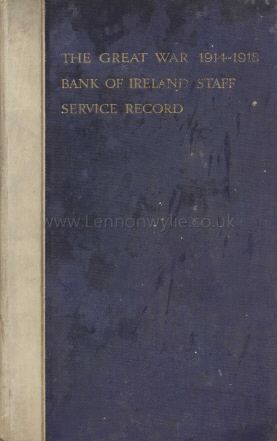
Bank of Ireland Staff Service Record
compiled by
Thomas F. Hennessy
1920
To Our Heroic Dead and to Our Gallant Colleagues Who
Fought With Them
Foreword:
It seemed to the Governors and Directors of the Bank of Ireland only right
and fitting that this record should be compiled to perpetuate the memory of
those members of the Bank who, in the dark days of the Great War,
voluntarily came forward to fight for their country; ready, if need be, to
make the great sacrifice for her sake.
Such men are not to be forgotten.
We welcome those who have come back to us.
We mourn for those who shall return no more -
"But trust that those we call the dead
Are breathers of an ampler day
For ever nobler ends."
G. F. S.
October 1920
Preface:
In July,
1914, the male Staff of the Bank of Ireland numbered six hundred and
twelve, about one-third of whom were over military age. Some of the
officials were members of Volunteer Forces and a few were Army
Reservists, but the great majority knew nothing of the art of War, and
never expected that the time would come when they would be called upon
to take up arms on behalf of their country. At the outbreak of the
great world struggle, the Board of the Bank determined that every
possible effort should be made to release men for the new Armies in
order to help in stemming the tide of the then unbeaten forces of the
greatest military Power in the world. With this object in view, they
made an Order granting half-pay, and a guarantee of reinstatement after
the War, to all employees who volunteered. Lord Kitchener's call for men
was issued about the same time, and was quickly responded to by the
members of the Bank's Staff. So eager were men to join the colours, that
in some instances, they left their posts in the Bank and enlisted,
without acquainting those in authority, or waiting for formal permission
to volunteer. The Board were thus faced with the problem of disorganisation
of the Bank's business, and, to enable the work to be carried on with an
already depleted staff, were obliged to suspend their Order, and
subsequent applications for permission to volunteer were treated in
rotation as circumstances permitted.
During the War period one hundred and ninety Bank of
Ireland men, or almost one-third of the entire male Staff at the
outbreak of the struggle, served in the Forces. Of these, one hundred
and eighty-nine were volunteers, and only one was called up under the
Military Service Acts. It must also be stated, in fairness to those
concerned, that, owing to the difficulty of making arrangements for
carrying on the business of the Bank during their absence, it was found
impossible to release many of the volunteers as early in the struggle as
they desired, and a further number were obliged to remain at their posts
in the Bank after having expressed their willingness to serve. Men of
almost every rank in the Bank, from Director to Porter, married and
single, freely offered their services, and, realising all that was at
stake, left their posts to engage in the great conflict. The greater
proportion of those who volunteered joined the ranks at the outset, but
were subsequently granted Commissions; while, in several cases, men who
enlisted as Privates preferred to remain in the ranks. Many of the
officials attained high rank in the new Armies, and there is an instance
of a caretaker at one of the Branches who enlisted, and was afterwards
promoted to commissioned rank.
The Distinctions gained by Bank of Ireland men in the
War number 40, and in several instances double honours have been won. An
ex-official of the Bank, Sec. Lieut. Edmund de Wind, Royal Irish Rifles,
who resigned the service prior to the War in order to emigrate, was
awarded the Victoria Cross, but gave his life in performing the gallant
deed which won for him the coveted distinction. Forty-seven of those who
joined the Forces were wounded, some of them severely - in one
instance necessitating the loss of an arm, and in another, the loss
of a leg. Nine were taken prisoners - one by the Turks, and eight by
the Germans.
Bank of Ireland men have served their country in the
War on land, on sea, and in the air, with credit to themselves and
to the Bank. They have served in places so widely separated as
Russia and German East Africa, India and France, the North Sea and
the Mediterranean. They have commanded batteries in Flanders, swept
mines in the Adriatic, driven "caterpillars" in Mesopotamia, hunted
submarines in the Channel, and fought duels in mid-air on several
fronts. One of them, a Royal Irish Lancers reservist, fought with
distinction "from Mons to Mons," and has survived the ordeal.
In the following pages will be found brief particulars
of the services rendered to King and Country in the War by the
members of the Bank's Staff. In many instances we are fortunately
able to print extracts from letters received from Regimental
Officers and comrades of those who fell, but in some cases it has
not been possible to do this. We feel assured that this is not due
to any want of appreciation of the services of the fallen, but to
force of circumstances.
Happily a large number of those who served have
returned to their peaceful duties in the Bank; and, while
congratulations and thanks are extended to those who have come
safely through the struggle, out gratitude is especially due to the
thirty-three members of the Staff who will never return. Some were
mere boys - all were true men. They little thought that the time
would come when they would be acclaimed as heroes. War, with all its
horrors and privations, its bloodshed and its sorrow, was utterly at
variance with their very natures, but they went forth, cheerfully
and willingly, to fight in a cause which they knew was just. They
lie in France and Gallipoli, Belgium, Serbia and Egypt. They have
raised to themselves a glorious monument in the triumph of the cause
for which they fought; and the magnitude of their sacrifice on the
altar of duty will ever be an inspiration to those who remain.
T. F. H.
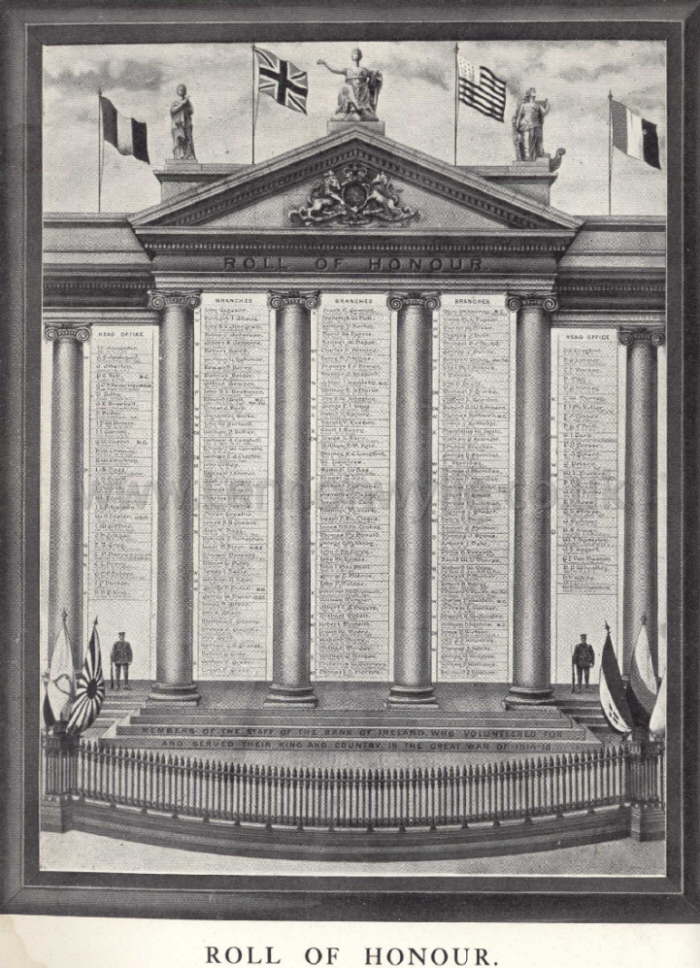
Roll of Honour
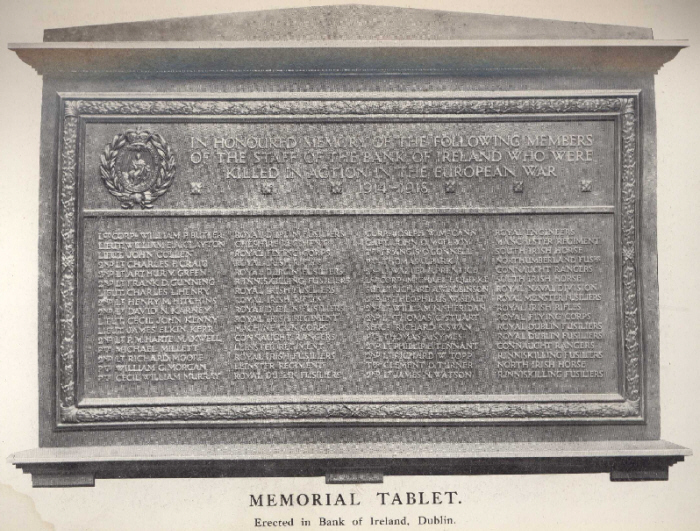
Memorial Tablet - Erected in Bank of Ireland, Dublin
ROLL OF HONOUR
Members of the Staff Killed in Action, Died of Wounds, etc.
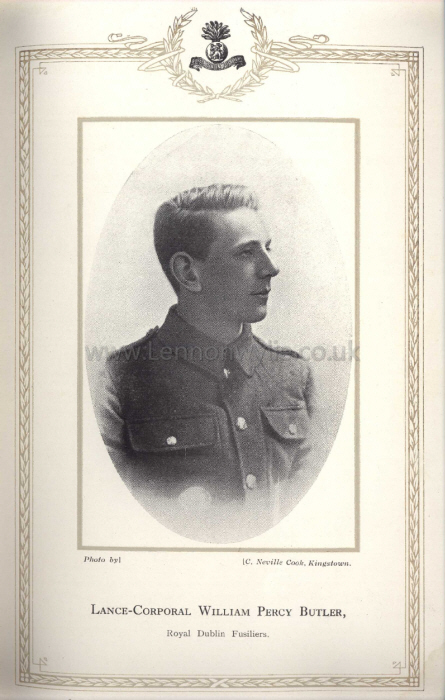
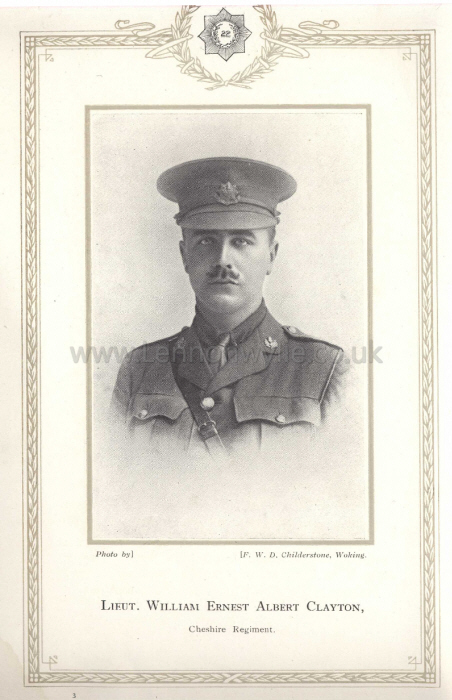
1
2
Lance-Corporal William Percy Butler
Lieut. William Ernest Albert Clayton
Royal Dublin Fusiliers
Cheshire Regiment
Photos by C. Neville Cook, Kingstown
F. W. D. Childerstone, Woking
1. Eldest son of W. J. Butler,
Esq., M.A., 36 York Road, Kingstown, Co. Dublin. Educated at Corrig
School, Kingstown, and entered the service of the Bank in April, 1915.
He enlisted in 10th Battalion Royal Dublin Fusiliers in February, 1916,
and served during the rising in Dublin. He was sent to France in the
following August, and after serving on various fronts, was mortally
wounded by shell-fire in action at Gavrelle (supposed) on 23rd April,
1917, and died at No. 19 Casualty Clearing Station on the next day.
The following extracts have been taken from letters
received by his parents, viz.:-
Platoon Commander: "Your son was a thoroughly reliable soldier, in whom
his officers had every confidence, and his loss is much felt by his
comrades in the Battalion, amongst whom he was most popular."
A comrade: "No man ever had a better chum - he was always the same -
even under the most trying circumstances he never grumbled."
2. Son of Rev. W. J. Clayton, The Manse,
Warrenpoint. Educated at the Methodist College, Belfast, and entered the
service of the Bank in June, 1907. Shortly after the outbreak of War he
joined Queen's University O.T.C., and was commissioned in 11th Batt.
Cheshire Regiment in December, 1914. He was sent to France in December,
1915, and was appointed Bombing Officer to the 9th Battalion. He was
mortally wounded when on duty in support trenches near La Bassée on 13th
April, 1916, and died from the effects nine days later, at the Casualty
Clearing Station, Merville.
The following extracts have been taken from letters
received by his relatives, viz:-
Lieut.-Colonel: "He was one of my most valued Officers. Nothing he was
asked to perform was too much for him, and his willingness and the
energy with which he undertook any new duties were a splendid example to
the other Officers and the men under him. He was universally loved and
respected by the whole Battalion, and is a great loss to me personally,
to the Battalion, and most especially to his Company, in which he had
the greatest influence."
Captain: "He was quite the cheeriest fellow, and we miss him no end."
Lieutenant: "The loss to the Company is a great one. The men were very
fond of him, and he was the very soul of cheerfulness, and life of the
mess."

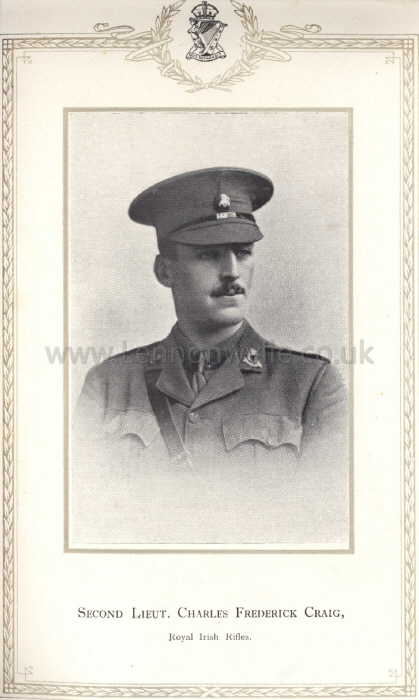
1
2
Lieut. John Collen
Second Lieut. Charles Frederick Craig
Royal Flying Corps.
Royal Irish Rifles
1. Son of F. D. Collen, Esq., Carricklee, Levaghery,
Portadown. Educated at Campbell College, Belfast,
and entered the service of the Bank in May, 1914. He enlisted in the 7th
Batt. Leinster Regiment (Cadet Corps) in June , 1915, and was
subsequently gazetted to a Commission in the 7th Batt. Royal
Inniskilling Fusiliers. He was sent to France in February, 1916, and
took part in actions at Loos and in the memorable gas attack at Hulloch.
In August following he was transferred to the Royal Flying Corps, and
qualifying for his badge in a short time, was attached to the 7th
Squadron, and was principally employed as observer. He was engaged in
this work, when his machine was brought down near Pys, about a mile on
the German side of the lines, on the morning of 25th October, 1916. He
was officially posted as "missing" on that date, and all efforts have
failed to obtain definite information as to his fate.
The following extracts have been taken from letters
received by his relatives, viz.:-
Major: "A keen and reliable observer, always ready to do his share of
work."
Flight Commander: "I found him a very excellent and trustworthy officer;
he was a favourite in the mess."
Captain: "I have had him up with me on several occasions, and have
always found him most reliable and cool, and good at his work. I am sure
he would have made a very good pilot if the luck had been his."
2. Son of John Craig, Esq., Kildare Street, Newry.
Educated at Newry Intermediate School, and in Belfast, and entered the
service of the Bank in April, 1911. He was commissioned in the 7th Batt.
Royal Irish Rifles in October, 1915, and was subsequently attached to
the 10th Batt. of the same Regiment. On being sent to France in June,
1916, he took part in the opening stages of the Somme offensive. After
two days of severe fighting at Thiepval on 1st and 2nd July, 1916, his
Battalion was relieved, he being the only surviving Officer of his
Company. He was killed by a shell on the following day.
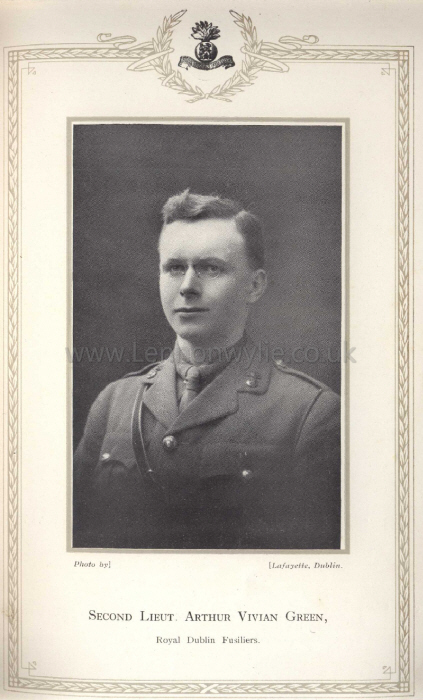

1
2
Second Lieut. Arthur Vivian Green
Second Lieut. Frank Douglas Gunning
Royal Dublin Fusiliers
Royal Inniskilling Fusiliers
Son of Herbert P. Green, Esq.,
Limehurst, Holland Park, Knock, Co. Down. Educated at the Methodist
Collage, and Royal Academical Institution, Belfast, and entered the
service of the Bank in July, 1913. He joined the Inns of Court O.T.C. in
January, 1916, and was commissioned in the 5th Batt. Royal Dublin
Fusiliers in December, 1916. Subsequently attached to the 8th Batt., he
was sent to France in February, 1917, and took part in actions at
Messines, Wytschaete, and the Ypres-Menin Road. He was killed near Ypres
on 17th August, 1917, by shell-fire whilst leading his platoon.
The following extracts have been taken from letters
received by his relatives, viz.:-
Captain: "In all extremities he was the same genial and lion-hearted
boy, and his men were absolutely devoted to him."
Lieutenant: "He was a fine Officer. He was deeply religious in his own
quiet unassuming way - and this must have influenced for good many of
those who knew and loved him."
Sec. Lieut.: "His character was one of the finest I have met with."
Chaplain: "We have still with us the sweet memory of his noble life and
example." 2. Son of the Late
Sinclair Gunning, Esq., Willoughby Place, Enniskillen. Educated at
Portora Royal School, Enniskillen, and entered the service of the Bank
in May, 1912. He enlisted in the 7th Batt. Royal Dublin Fusiliers (Pals)
in September, 1914, and left England for active service with the
Mediterranean Forces in July, 1915. He took part in the landing at Suvla
Bay, Gallipoli, in the following August, and was subsequently invalided
home with dysentery. After recovery, he was commissioned in the 6th
Batt. Royal Inniskilling Fusiliers, and in June, 1916, was sent to
France to the 11th Battalion. On 1st July, 1916, he led the
"Enniskillen" platoon of his Company in the officially reported "killed
in action" on that date.
The following extracts have been taken from letters
received by his relatives :-
Co. Commander: "He was a splendid Officer, and one we were all proud of.
He was a great favourite with both officers and men, and the survivors
of his platoon speak in the highest terms of how he led them across 'no
man's land' in the face of heavy shell and machine-gun fire. We all miss
him."
A returned Soldier: "A bullet took off one of his fingers, and as he was
binding it up, his men begged him to go back to the dressing station. He
refused - 'his place was with them,' he said - and he went on until a
shell extinguished his bright and noble spirit."
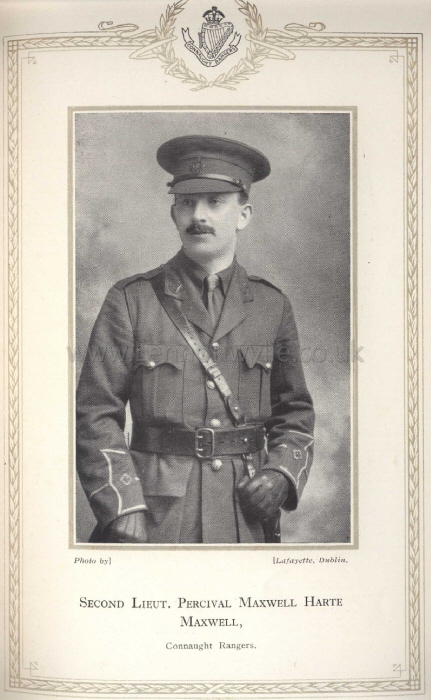
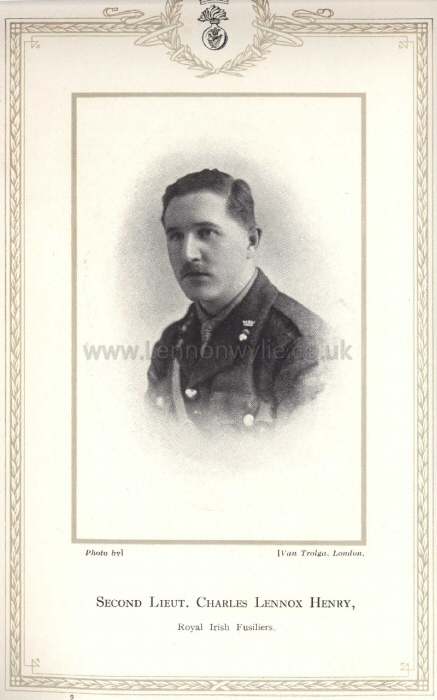
1
2
Second Lieut. Percival Maxwell Harte Maxwell
Second Lieut. Charles Lennox Henry
Connaught Rangers
Royal Irish Fusiliers
1. Son of Samuel M. Harte Maxwell,
Esq., Glen Albert, Roscrea, Co. Tipperary. Educated at Fermoy Grammar
School, and entered the service of the Bank in June, 1905. He enlisted
in the King's Own Dragoon Guards in September, 1914, and was
subsequently commissioned in the Connaught Rangers. On being sent to
France, he was attached to the Royal Irish Rifles and was killed in
action at Armentieres on 10th April, 1916.
2. Youngest son of James Henry, Esq., LL.B., 32
Belgrave Square, Rathmines, Co. Dublin. Educated at Wesley College,
Dublin, and entered the service of the Bank in February, 1914. He
enlisted in the 7th Batt. Royal Dublin Fusiliers (Pals) in September,
1914, and took part in the landing at Suvla Bay, the Serbian Retreat,
and subsequent operations at Salonica. He was sent home to a Cadet Corps
in July, 1916, and was gazetted to a Commission in the Royal Irish
Fusiliers in January, 1917. He was afterwards sent to France, awarded a
Parchment Certificate for gallantry, and was killed in action at
Messines on 16th August, 1917.
The following extract has been taken from a letter
received by his relatives :-
Colonel: "He was a magnificent type of Officer, and had been specially
selected by me to lead his Company. He was loved by his men."
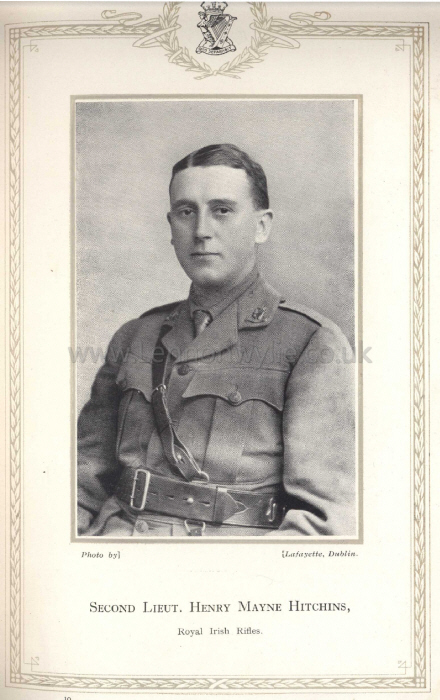
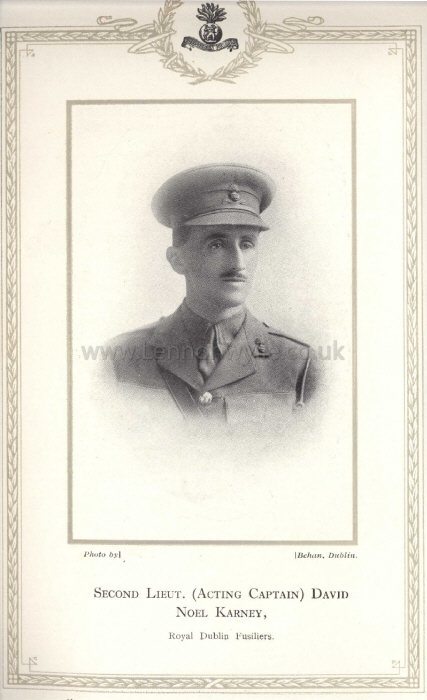
1
2
Second
Lieut. Henry Mayne Hitchins
Second Lieut. (Acting Captain) David Noel Karney
Royal Irish Rifles
Royal Dublin Fusiliers
1. Son of Henry Hitchins, Esq., 39
Sandycove Road, Kingstown, Co. Dublin. Educated at Chesterfield, Birr,
King's Co., The High School, Dublin, and T.C.D., and entered the service
of the Bank in April, 1901. He enlisted in the 7th Batt. Leinster
Regiment in October, 1914, and was subsequently commissioned in the
Royal Irish Rifles. On being sent to France in December, 1915, he was
attached to a Trench Mortar Battery, and was killed in action near
Vermeilles on 18th August, 1916.
The following extract has been taken from a letter
received by his relatives, viz.:-
Senior Chaplain: "It is only a short time ago since he saved the life of
an Officer who was bleeding to death from a wound. His coolness and
resource under shell-fire was well known to us all, and we mourn one who
was loved by all who knew him, and especially the men of his Battery."
2. Eldest son of J. B. Karney, Esq., 100 Leinster
Road, Rathmines, Co. Dublin. Educated at Sir John Ivory's School,
Edinboro', and entered the service of the Bank in May, 1907. He enlisted
in the 7th Batt. Royal Dublin Fusiliers (Pals) in December, 1914, and
left England for service with the Mediterranean Forces in July, 1915. He
took part in the landing at Suvla Bay, and was wounded whilst on the
Peninsula. After spending over a year in Hospital at Cairo, he was sent
to Serbia, and took part in several engagements on the Struma. He
subsequently contracted malaria, was invalided home in 1917, and on
recovery joined the Cadet Corps at Moore Park. He was afterwards
commissioned in the Royal Dublin Fusiliers, and was sent to
France, where he took part in the capture of the Hindenburg Tunnel. He
was appointed Acting Captain in January, 1918, and was awarded a
Parchment Certificate for gallantry in the field. He was subsequently
placed in command of a Company of the 2nd Batt. Royal Dublin Fusiliers,
with orders to hold the position, and was killed in action on 21st
March, 1918.
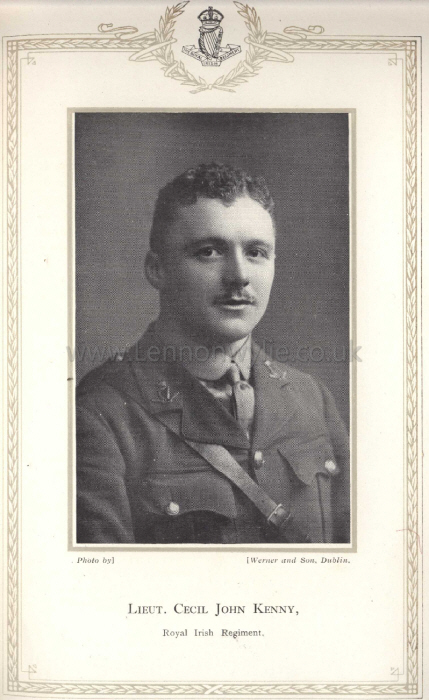
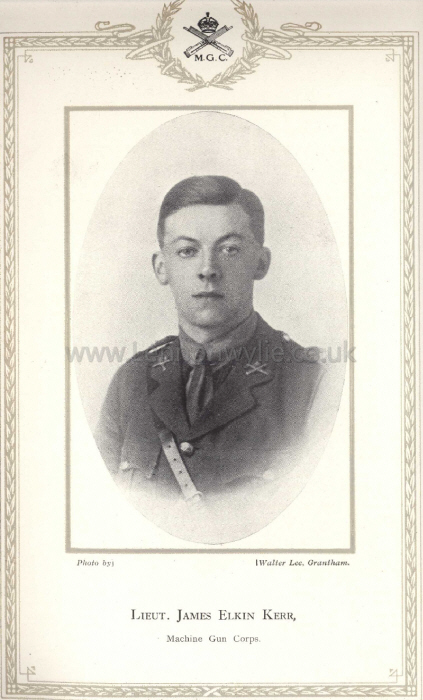
1
2
Lieut. Cecil John Kenny
Lieut. James Elkin Kerr
Royal Irish Regiment
Machine Gun Corps
1. Third son of H. B. Kenny, Esq.,
Clyduffe House, Roscrea, Co. Tipperary. Educated at the Grammar School,
Tipperary, and entered the service of the Bank in July, 1913. He
enlisted in the Royal Engineers, Motor Cyclist Despatch Rider, in
December, 1914, and was commissioned in the 10th Batt. Royal Irish
Regiment early in 1915. On completion of his training he was sent to
France as Signal Officer to his Battalion, and was wounded in action in
July, 1916. After recovery, he was attached to the 30th Batt. Machine
Gun Corps, and after taking part in severe fighting on various fronts,
he was killed in action by a German Sniper at Ham, near St. Quentin, on
24th March, 1918.
The following extracts have been taken from letters
received by his relatives, viz.:-
Officers of C. Company: "He was universally loved by his brother
officers and men, and we are very proud of his association. He died
fighting in an endeavour to save his gun. For two days he had bluffed
the Boche and held up their attack, persuading the infantry to hold the
line with him. He could have got away, but scorned to do so without his
gun."
Adjutant: "He was a perfect gentleman in the very best sense of the
word, and a splendid Officer as well. He was one of those characters who
are incapable of doing anything that is not straight, honest, and kind.
He managed his guns marvellously."
2. Son of Mrs. J. McSweeney, Diamond, Carndonagh,
Co. Donegal. Entered the service of the Bank in April, 1911, and
enlisted in the Royal Engineers as Motor Cyclist Despatch Rider in
April, 1915. He was commissioned in the Yorkshire Regiment in June
following, and was subsequently transferred to the Machine Gun Corps,
and promoted Lieutenant. He was sent to France in April, 1916, and took
part in severe fighting at Ypres, Loos, on the Somme and in Belgium. He
was wounded in action at Ypres in May, 1916, and again at Guillemont in
the following August, and was mortally wounded by shell-fire near
Dunkirque on 10th September, 1917.
The following extracts have been taken from letters
received by his relatives, viz.:-
Co. Commander: "He died as he lived - a gallant soldier."
Lieutenant: "His death was a great blow to us all, for he had attained
great popularity both with officers and men. The Company has lost one of
its most capable Officers."
Chaplain: "We all miss him a great deal - he was a good Officer and
staunch friend."
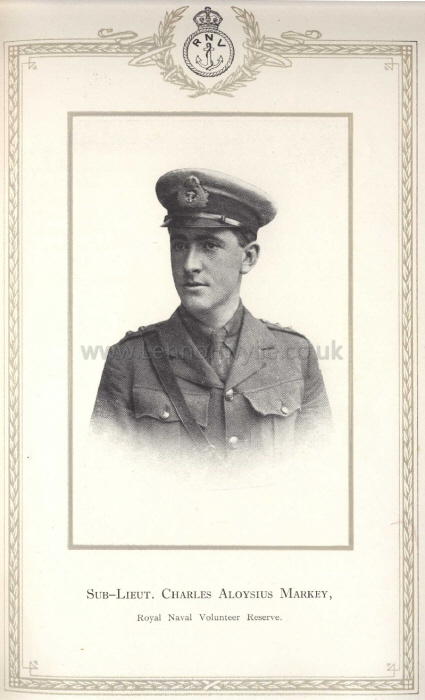
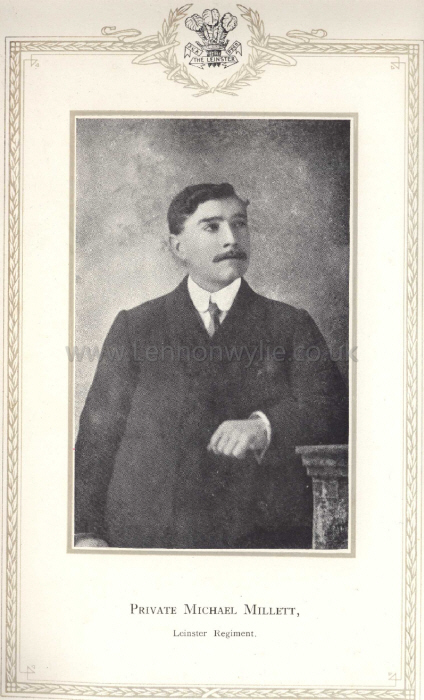
1
2
Sub-Lieut. Charles Aloysius Markey
Private Michael Millett
Royal Naval Volunteer Reserve
Leinster Regiment
1. Fourth son of the late Patrick
Markey, Esq., Hibernian Bank, Navan, and Mrs. Markey, 8 Terenure Park,
Terenure, Co. Dublin. Educated at Clongowes Wood College, and entered
the service of the Bank in May, 1912. He was commissioned in the Royal
Naval Volunteer Reserve, "Hood" Battalion, in June, 1915, and was sent
To Gallipoli in October following. After serving during the evacuation,
he was sent to France, and took part in engagements at Beaumont Hamel
and was gassed at the capture of Beaucourt. He was invalided home for a
month to recuperate, and on returning to France, took part in a forced
march, which aggravated his weak state of health. He was then ordered
into hospital at Le Touquet, and was subsequently invalided home for six
months. At the expiration of that period he was posted to Blandford for
light duty. As his ill-health continued, he was sent to a sanatorium,
and in August, 1919, was sent home, where he died on 23rd January, 1920.
2. Army Reservist, and was called up to the
Leinster Regiment at the outbreak of War. After a short training, he was
sent to France in September, 1914, with the original Expeditionary
Force, and was killed in action on 20th October, 1914.

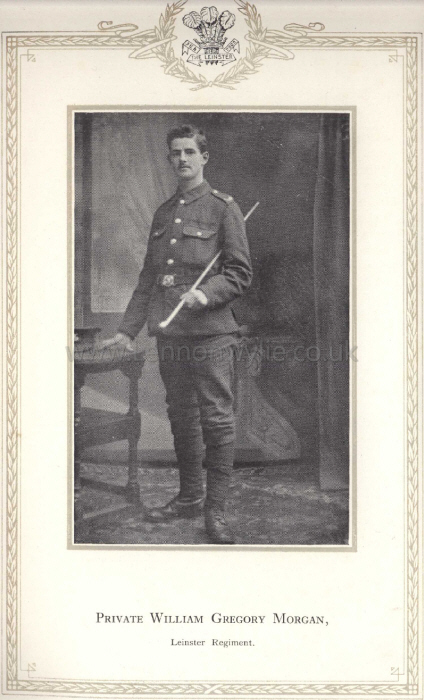
1
2
Second Lieut. Richard Moore
Private William Gregory Morgan
Royal Irish Fusiliers
Leinster Regiment
1. Had served twenty-one years in
the Royal Irish Rifles prior to the War, and joined the 11th Battalion
in July, 1915, and was sent to France as Company Quarter-Master
Sergeant. He was promoted Regimental Quarter-Master Sergeant in 1916,
and returned in that capacity to the Depot at Clandeboye, Co. Down. In
September, 1917, he was gazetted a Temporary Second Lieutenant from the
O.T.C., Cambridge, and with that rank joined the 2nd Garrison Battalion,
Royal Irish Fusiliers, at Berehaven. He was subsequently transferred to
Salonica, where he died of dysentery on 29th October, 1918.
2. Son of A W. Morgan, Esq., 93 Donore Terrace,
South Circular Road, Dublin. Educated at Diocesan Schools, Molesworth
Street, Dublin, and entered the service of the Bank in January, 1915. In
April, 1915, he enlisted in the 7th Batt. Leinster Regiment (Cadet
Corps), in which he became an efficient bomber. He was sent to France in
December, 1915, and after seeing considerable service on the Arras and
Somme fronts was killed in action at Guillemont on 3rd September, 1916.
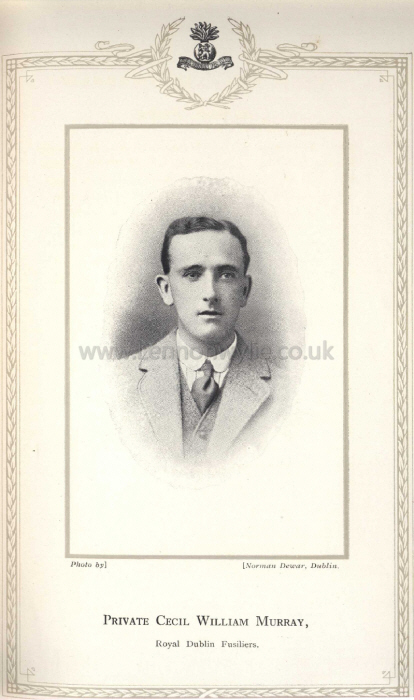

1
2
Private Cecil William Murray
Corporal Joseph William McCann
Royal Dublin Fusiliers
Royal Engineers
1. Son of Mrs. B. J. Murray, 17b
Dartmouth Square, Dublin. Educated at Waterford, and entered the service
of the Bank in June, 1901. He enlisted in the 7th Batt. Royal Dublin
Fusiliers (Pals) in September, 1914, and left England for active service
with the Mediterranean Forces in July, 1915. He took part in the landing
at Suvla Bay, and was killed in action at Kis-lar-Dagh, Gallipoli, on
16th August, 1915. 2. Son of
Mrs. McCann, Keatings Park, Rathcoole, Co. Dublin. Entered the service
of the Bank in April, 1911, and enlisted in the Royal Engineers as Motor
Cyclist Despatch Rider in September, 1914. He was attached to the
Mediterranean Expeditionary Force, and died of dysentery on 23rd August,
1915.
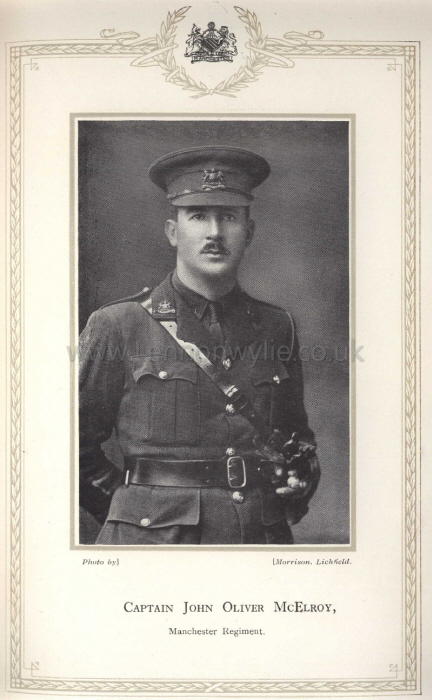

1
2
Captain John Oliver McElroy
Trooper Francis O'Connell
Manchester Regiment
South Irish Horse
1. Third son of the late George
McElroy, Esq., of Cuilmore, Gurteen, Co. Sligo. Entered the service of
the Bank in July, 1900. He was commissioned in the Manchester Regiment
in July, 1915, and was posted to the 18th Batt. in France in May, 1917.
He was wounded at Courtrai in August, 1917, and was taken prisoner by
the Germans at Passchendaele in the following December. After spending
almost a year in captivity, he was repatriated on 26th November, 1918,
and whilst awaiting demobilisation, died on 5th March, 1919, at the
Military Hospital, Grimsby, from pneumonia following influenza.
2. Son of Richard O'Connell, Edq., Rathvin,
Fethard, Co. Tipperary. Educated at St. Mary's College, Knockbeg,
Carlow, and entered the service of the Bank in May, 1915. He enlisted in
the South Irish Horse in May, 1916, and was sent to France in the
following September. He served various periods of dismounted duty in the
trenches, and was killed by the explosion of a mine when on mounted
patrol duty at Rausart, south of Arras, on 19th March, 1917.
The following extracts have been taken from letters
received by his relatives, viz.:-
Lieutenant: "His loss is very much felt by all: he was very popular, and
had done very well while with us."
Comrade: "He and another cavalryman were on reconnaissance when their
horses became entangled in wire laid by the Germans. This caused a mine
to explode which killed him instantly, and his companion, who survived
an hour. You have lost as fine a fellow as ever put foot in France, and
I have lost a pal whom I felt was dearer to me than a brother."

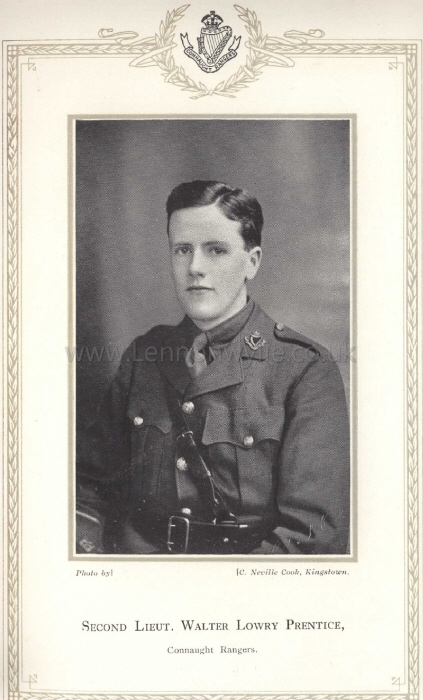
1
2
Private Thomas
J. Park
Second Lieut. Walter Lowry Prentice
Northumberland Fusiliers
Connaught Rangers
1. Son of the late Thomas Park,
Esq., of Limavady, Co. Derry. Rejoined his old Battalion - 5th
Northumberland Fusiliers - in August, 1914, shortly after the outbreak
of War, and was soon afterwards sent to France. He took part in much
severe fighting in that country, and was wounded in the spine at Hill 60
in 1915. He spent three months in an hospital in England, and was then
transferred to Dublin, where he died as the result of his wounds on 1st
January, 1916. 2. Youngest
son of the late B. Maziere Prentice, Esq., Agent, Bank of Ireland,
Roscrea, Co. Tipperary. Educated at Castle School, Roscrea, and Avoca
School, Blackrock, Co. Dublin, and entered the service of the Bank in
November, 1910. He was commissioned in the 4th Batt. Connaught Rangers
in November, 1915, went to France in the following May, and was attached
to the 1st Batt. Royal Inniskilling Fusiliers. He was wounded in
December, 1916, during the Somme movement, and invalided home. He
returned to France in May, 1917, attached to the 2nd Batt. Leinster
Regiment, and took part in actions at Messines and Passchendaele. He was
mortally wounded on 31st July, 1917, whilst leading his platoon in the
Passchendaele Battle, and died at No. 2 Canadian Clearing Station on 3rd
August, 1917.
The following extracts have been taken from letters
received by his relatives:-
Lieut.-Colonel: "He had only served with us for a short time, but all
ranks had learned to esteem his high qualities as a leader, and his loss
is sorely felt. He was a gallant Officer and a good one, but has died a
soldier's death in a good cause. I shall miss him very much in the
Battalion for he was one of our most promising officers."
Lieutenant: "As for the men, they lost not only a gallant and efficient
Officer, but also a great friend, as he took a very personal interest in
their welfare and comfort. He was the first over the parapet of our
trench with the leading platoon."
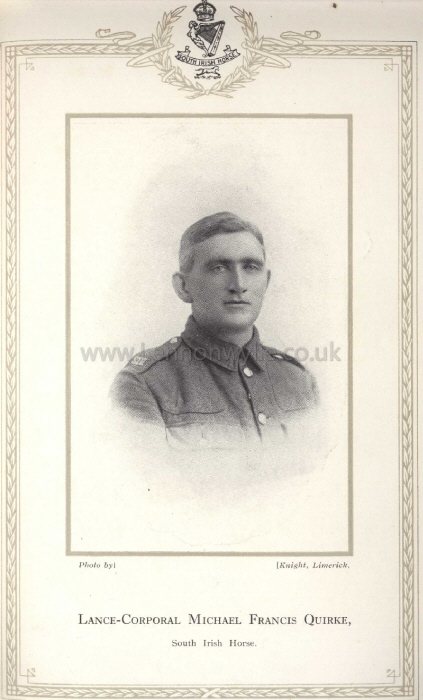
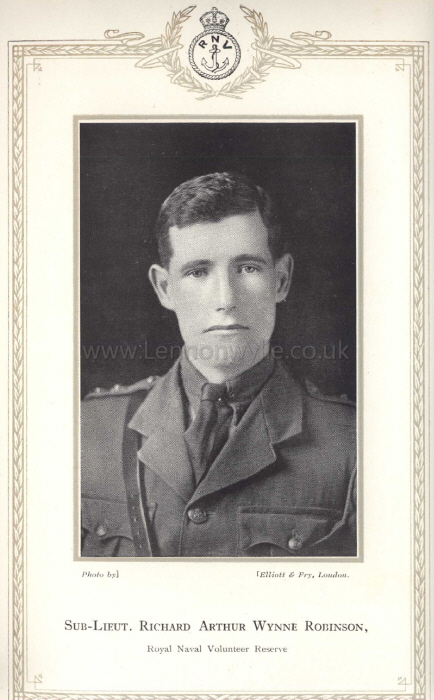
1
2
Lance-Corporal Michael Francis Quirke
Sub-Lieut. Richard Arthur Wynne Robinson
South Irish Horse
Royal Naval Volunteer Reserve
1. Son of the late Edmond Quirke,
Esq., of Pallas, Donohill, Co. Tipperary. Educated at Christian
Brothers' Schools, Tipperary, and entered the service of the Bank in
May, 1904. He enlisted in the South Irish Horse in January, 1915, and on
being sent to France, was attached to the 7th Batt. Royal Irish
Regiment, and promoted Lance-Corporal. After taking part in heavy
fighting at various sectors, he was dangerously wounded on 17th
December, 1917, and admitted into No. 5 General Hospital, Rouen, where
he died on the following day, after having his right arm and left leg
amputated. 2. Son of Rev. A.
C. Robinson, Ballymoney Rectory, Ballineen, Co. Cork. Educated at Cork,
and Grammar School, Bandon, and entered the service of the Bank in May,
1904. In Oct., 1908, he married Clemena Mary Elizabeth, only child of
the late George Peirce Ridley, M.D., Tullamore. He joined the Royal
Naval Volunteer Reserve in August, 1915, and was commissioned in January
following. He was sent to France in December, 1916, with the Drake
Battalion, Royal Naval Division, and was mortally wounded in action near
Albert on 5th February, 1917.
The following extracts have been taken from letters
received by his relatives:-
Office: He behaved magnificently: he was responsible for the carrying of
ammunition up to the firing line of one of our Battalions - a most
important thing - and it was work full of danger, but I know he worked
absolutely regardless of his own personal safety. He is a great loss to
the Battalion, because he was one of the most manly Officers we had, and
we all loved him, and I know that he was very popular with his men."
Officer: "He was cheery to the last, like the splendid soldier he was."
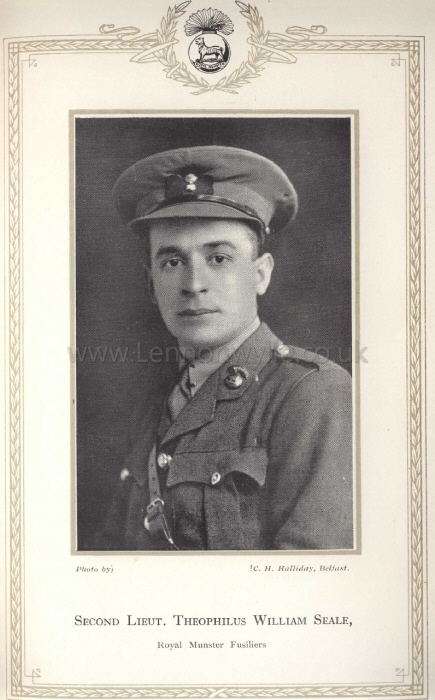

1
2
Second Lieut. Theophilus William Seale
Second Lieut. William Nicholas Sheridan
Royal Munster Fusiliers
Royal Irish Rifles
1. Son of the late Richard Seale,
Esq., Clonmel, and of Mrs. M. L. Seale, Gleneden, Tipperary. Educated at
the Methodist College, Belfast, and entered the service of the Bank in
May, 1902. He enlisted in the South Irish Horse in September, 1914, and
was subsequently promoted Corporal. In August, 1915, he was commissioned
in the 7th Batt. Royal Munster Fusiliers, was sent to France, and had
been only two days in the front line trenches, when he was killed at the
Somme on 22nd August, 1916.
The following extract has been taken from a letter
received by his relatives:-
Adjutant: "He was one of the best of our young Officers, and his loss
will be greatly felt." 2.
Eldest son of Robert Sheridan, Esq., D.I., R.I.C., Banbridge. Educated
at Omagh Academy and Foyle College, Londonderry, and entered the service
of the Bank in April, 1912. He joined the Inns of Court O.T.C. in June,
1915, and was commissioned in the Royal Irish Rifles in October, 1915.
He was subsequently transferred to a School of Instruction in Dublin,
and was awarded a First-Class Certificate in Bombing. On completion of
his course he was appointed Battalion Instructor, which position he held
until his departure for France in July, 1916. He was killed in action by
shell-fire on 1st September, 1916.
The following extracts have been taken from letters
received by his relatives:-
Colonel: "We shall miss him very much indeed. Though he had been with us
only a short time, he had done good work, and was an excellent Officer."
Officers of A, Company: "By his jovial manner and kindness of heart he
had endeared himself to us all and we mourn his loss very much."
Lieutenant: "His death will leave me missing one of my best comrades."
Sec. Lieutenant: "From what I have heard he lost his life in an effort
to save one of his men, which I believe he succeeded in doing at the
great cost of his own: and how can man die better?"
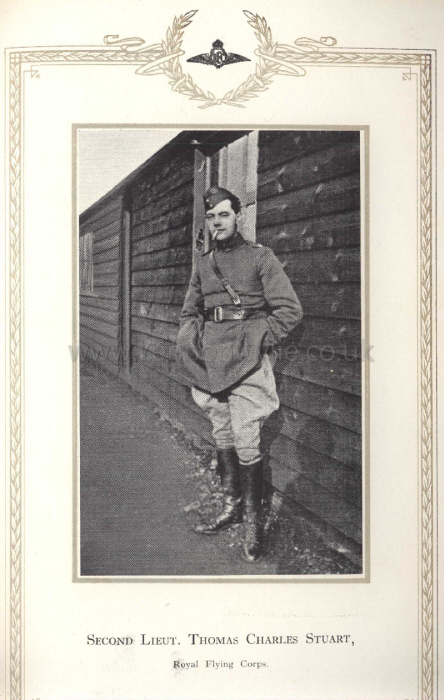
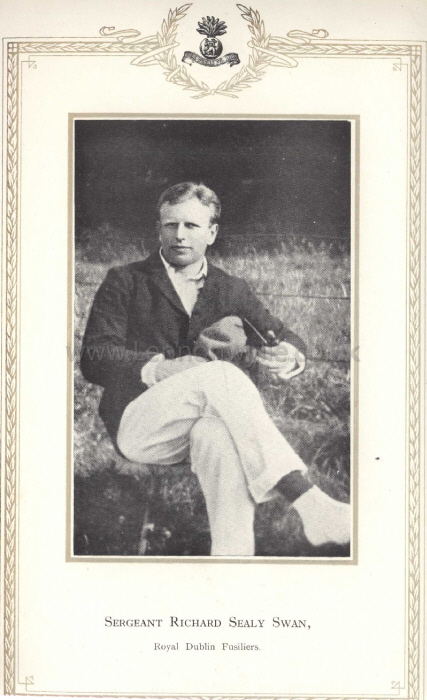
1
2
Second Lieut. Thomas Charles Stuart
Sergeant Richard Sealy Swan
Royal Flying Corps.
Royal Dublin Fusiliers
1. Son of Samuel Stuart, Esq.,
Beechgrove, Arklow, Co. Wicklow. Educated at Mountjoy School, Dublin,
and entered the service of the Bank in April, 1914. He joined the Inns
of Court O.T.C. in June, 1917, and in the following October transferred
to the Royal Flying Corps. He trained at various Schools of Aeronautics
in England, and was due for service in France when the signing of the
Armistice concluded hostilities. He was then sent to Marske-by-the-Sea,
Yorkshire, where he contracted influenza, followed by pneumonia, to
which he succumbed on 12th December, 1918, at the Military Hospital,
Redcar, Yorkshire. 2. Son of
the late Thomas Swan, Esq., and of Mrs. E. F. Swan, 3 Winslow Terrace,
Terenure Road, Dublin. Educated at the High School, Dublin, and entered
the service of the Bank in May, 1897. He enlisted in the 7th Batt. Royal
Dublin Fusiliers (Pals) in September, 1914, and left England for active
service with the Mediterranean Forces in July, 1915. He took part in the
landing at Suvla Bay, Gallipoli, and subsequent severe fighting on the
peninsula. He was afterwards promoted Sergeant, and was transferred with
his Battalion to Salonica, where he was invalided with malaria, and died
at No. 28 General Hospital, Salonica, on 15th August, 1916.
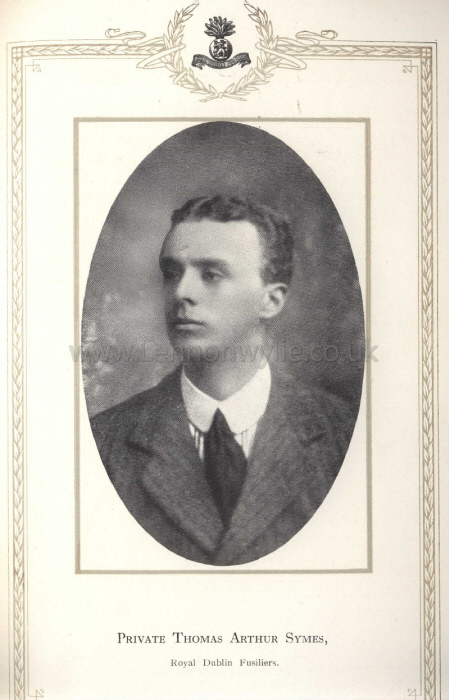
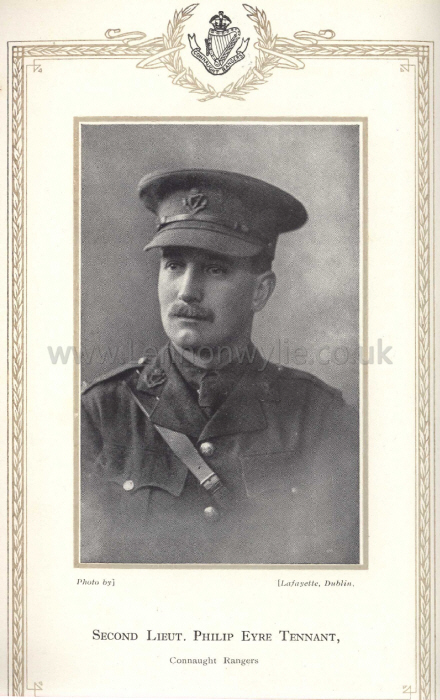
1
2
Private Thomas Arthur Symes
Second Lieut. Philip Eyre Tennant
Royal Dublin Fusiliers
Connaught Rangers
1. Son of Sandham J. Symes, Esq.,
of Hill View, Tinahely, Co. Wicklow. Educated privately, and entered the
service of that Bank in April, 1905. He enlisted in the 7th Batt. Royal
Dublin Fusiliers (Pals) in September, 1914, and left England for active
service with the Mediterranean Forces in July, 1915. He was one of the
Reserves landed at Mudros prior to the landing at Suvla Bay, and
contracted dysentery, from which he died on 18th August, 1915.
2. Son of the late John Tennant, Esq., Parkstown,
Thurles, Co. Tipperary. Educated at Multyfarnham, and entered the
service of the Bank in October, 1898. He joined the Inns of Court O.T.C.
in December, 1915, from which he was commissioned in the Connaught
Rangers in March, 1917. He was sent to France in the following May, and
was attached to the Leinster Regiment. He subsequently took part in
action at Messines Ridge, and was killed by an explosive bullet at
Shrewsbury Forest, near Ypres, on 31st July, 1917.
The following extract has been taken from a letter
received by his relatives, viz.:-
Battalion Commander: "He was a gallant Officer at all times, and his
Company Commander tells me that his gallantry was particularly
conspicuous on the day of his death. He is a great loss to us, and we
shall miss him very much."

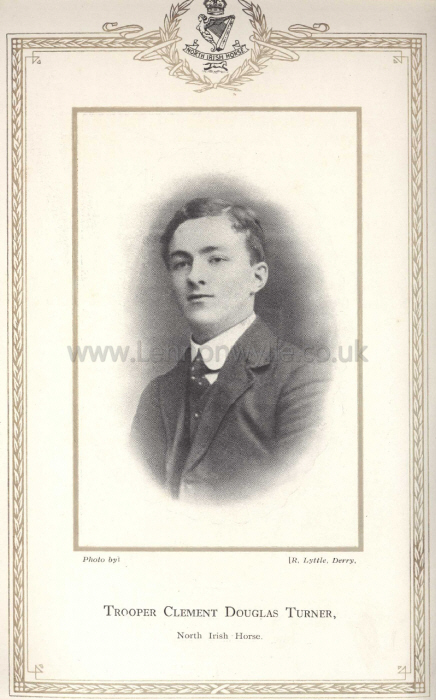
1
2
Second Lieut. Richard William Topp
Trooper Clement Douglas Turner
Royal Inniskilling Fusiliers
North Irish Horse
1. Eldest son of R. W. Topp, Esq.,
Agent, Bank of Ireland, Newry. Educated principally at The Grammar
School, Galway - where he held a Scholarship - and entered the service
of the Bank in July, 1915. He was commissioned in the 6th Batt. Royal
Inniskilling Fusiliers in February, 1916, and in the following June was
sent to France and attached to the 11th Battalion for the purpose of
completing his course of instruction behind the lines. Owing to his
efficiency, he was almost immediately transferred to the firing-line,
and placed in charge of a platoon, which he led through Thiepval Wood in
the Somme offensive on 1st July, 1916, but fell severely wounded by
shell-fire on that date. He was officially reported "wounded" and
subsequently "wounded and missing."
2. Son of the late R. Turner, Esq., Earl Street,
Longford, and of Mrs. Turner, 111 Ulsterville Avenue, Belfast. Educated
at King's Hospital, Dublin, and entered the service of the Bank in
April, 1915. He enlisted in the North Irish Horse in November, 1915, and
was sent to France in the following October. After seeing considerable
service he was killed in action at Ypres on 21st July, 1917, when
endeavouring to help a comrade.
The following extracts have been taken from letters
received by his relatives:-
Commanding Officer: "He was the youngest in his squadron, and a good
boy."
Lieutenant: "His death cast a gloom over us all. He was beloved by all,
and was killed instantaneously when going to help another."
Comrade: "He was one of the best - a brave boy. He died a glorious
death, and you ought to be proud of him."

Second Lieut. James Norman Watson
Royal Inniskilling Fusiliers
Son of the late James A. Watson,
Esq., and of Mrs. Frances Watson, Avon Lodge, Armagh. Educated at the
Royal School, Armagh, and entered the service of the Bank in November,
1911. He was commissioned in the 3rd Batt. Royal Inniskilling Fusiliers
in December, 1915, and was attached to the 1st Battalion in France in
July, 1916. He was gassed in action at Ypres Salient on 9th August,
1916, from the effects of which he died on the following day.
The following extract has been taken from a letter
received by his relatives:-
Commanding Officer: "He stayed at his post till morning came, and danger
of a following-up attack by the Germans had passed, and by his
cheerfulness and fine example to the men kept his platoon steady and
confident. He managed to walk to the dressing station about noon on the
10th, but collapsed when he got there. I wish to express to you our
sorrow at the loss of a good comrade and a fine soldier."
Roll of Honour
Members of the Staff who enlisted for the War
John Acheson - Joined Inns of Court O.T.C.
in January, 1916, and was gazetted Sec. Lieut. Royal Garrison Artillery
in following November. Sent to Salonika in January, 1917, and served in
the Balkans with 43rd Siege Battery until February, 1918, when he
transferred to R. F. Corps in Egypt. Appointed Lieutenant in May, and
was wounded in June, 1918. Awarded "Order of the Nile, 4th Class."
Herbert James Adams - Enlisted in 7th Batt.
Royal Dublin Fusiliers in September, 1914, and took part in Suvla Bay
landing in August, 1915, and subsequent operations at Gallipoli, being
wounded in action at Chocolate Hill. After recovery, he served with the
10th Batt. Royal Dublin Fusiliers during the Rebellion, and was
discharged "Unfit for further service" in May, 1916.
John Fenton Alexander - Enlisted in Royal
Army Service Corps, M. T. Section, in April, 1918, and served in England
until demobilised. John
Samuel Christian Allingham - Enlisted in Royal Irish Regiment in
November, 1916, was sent to France in March, 1918, and transferred to
7/8 Inniskilling Fusiliers after the March Retreat. He took part in
engagements at Locre, Neuve Eglise, Wervick, etc.
Robin Cecil Anderson - Joined Inns of Court
O.T.C. in November, 1915, and was commissioned in 5th Batt. Royal Dublin
Fusiliers in December, 1916. He served with the 10th (Service) Batt. and
2nd Batt. R. D. Fusiliers in France in 1917, and took part in actions at
Arras and Cambrai in that year. He was attached to the Indian Army in
February, 1918, and served with the 1/98th Infantry and 1/22nd Punjabis
on North-west Frontier until Marsh, 1919.
George Stuart Appleyard - Enlisted in 7th
Batt. Leinster Regiment in May, 1915, and was sent to France with 16th
Irish Division in the following December. Served at La Bassée, Hulloch,
etc., and was wounded in action in July, 1916. He was subsequently
gazetted Sec. Lieut. in 2nd Batt. Leinster Regiment, and served at
Hargicourt and on Menai front. He was wounded for the second time in the
attack on Ledgenham in October, 1918, and afterwards took part in the
advance to the Rhine. He was later promoted Lieutenant.
Albert Switzer Ashmore - Enlisted in Royal
Engineers as Motor Despatch Rider in December, 1914, and took part in
the landing at Suvla Bay in August, 1915. Sent to Serbia in December
following, and served on Macedonia until June, 1917. Gazetted to a
commission in 3rd Batt. Royal Inniskilling Fusiliers in January, 1918,
was sent to France in the following March, and attached to the 1st Batt.
of same Regiment. He was wounded at Ledgenhem in October, 1918, during
the advance from Ypres.
Aubrey Atherton - Commissioned in Royal
Army Service Corps in July, 1915, and was subsequently posted to 11th
Division at Suvla Bay, where he served until the evacuation, and
afterwards in Egypt. Sent to France in July, 1916, and served in that
country and in Flanders until demobilised. Promoted Captain in
September, 1917, and mentioned in despatches.
Robert Baird - Joined Artists Rifles
(2/28th Batt. London Regt.) O.T.C. in June, 1918, and was transferred to
20th O.C. Battalion in October following. He was subsequently gazetted
Sec, Lieut. County of London Regiment.
William Young Bateman - Joined Inns of
Court O.T.C. (Cavalry) in February, 1916, and was gazetted to R.H. and
R.F. Artillery in January following. He was attached to the 15th
Division in France in April, 1917, and took part in actions at Arras,
Ypres and Passchendaele. Sent to Italy with the 7th Division
subsequently, and took part in actions at Montello and Lower Piave, and
Asiago Plateau in 1918. He was promoted Lieutenant in July, 1918, and
returned to France in September following. Evacuated with bronchial
pneumonia in October, 1918.
Percy Charles Bell - Enlisted in South
Irish Horse in September, 1914, and served in France from December,
1914, until December, 1916, when he was sent home and commissioned in
the Royal Field Artillery. He was again sent to France in May, 1917, was
awarded the Military Cross in March, 1918, was wounded in action, and
subsequently promoted Lieutenant. Awarded M.C. "for gallantry and
devotion to duty in the field. It was mainly due to his wonderful
gallantry and cool organisation under intense hostile artillery and
machine gun fire that his guns were successfully withdrawn. He has
always shown exceptional keenness and devotion to duty worthy of the
highest traditions of the Regiment."
Rowan Netterfield Berry - Enlisted in South
Irish Horse in February, 1917, and transferred to Cavalry Officers'
Cadet School, Kildare, in September following. Gazetted 2nd Lieut. 1st
Reserve Cavalry Regiment (Lancers) in January, 1918.
Gerald O'Hagan Beveridge - Called up at
outbreak of War, he joined his Regiment - the South Irish Horse - on 5th
August, 1914, and was soon afterwards attached to the 49th West Riding
Division. In April, 1915, this formation was sent to France, and took
part in numerous actions, i.e., Festubert, Ypres, Passchendaele,
Cambrai, etc. In October, 1916, he was transferred to the Military
Mounted Police, and promoted Sergeant-Major, with which rank he served
until demobilised. He was awarded the Meritorious Service and Good
Conduct Medals.
Thomas Bibby - Enlisted in Royal Army
Service Corps, M.T. Section, in July, 1916, and was subsequently
appointed to the Examining Staff, and promoted Sergeant.
Patrick Bolger - Called up at the outbreak
of War, he saw considerable service with the Royal Army Service Corps in
France, where he was wounded and gassed in action.
Alfred Bowden - Enlisted in 3rd Batt.
Sherwood Foresters in May, 1918. Was subsequently sent to France, and
took part in actions at Le Cateau, Selle River, and Landrecies in the
advance of 1918.
John Henry Tilson Brabazon - Commissioned
in 4th Batt. Connaught Rangers in September, 1914, and was sent to
France in following April and wounded in action. After recovery he was
sent to Mesopotamia, was again wounded and taken prisoner by the Turks
in 1916, and was released after the Armistice.
Alfred Edward Brambell - Joined Royal
Engineers, as Motor Despatch Rider, in April, 1918, was sent to France
in the following October, and attached to the 1st Corps Heavy Artillery
in Belgium, with which he served until demobilised.
Edward Johnston Brett - Joined 18th Batt.
Royal Irish Rifles in June, 1915, and was commissioned in Special
Reserve (3rd Batt. Leinster Regt.) in July following. Seconded to
Machine Gun Corps in September, 1916, and posted to 18th Division in
November, 1916. Took part in 3rd Battle of Ypres, Passchendaele
offensive, March, 1918, and subsequent actions at Morlancourt, Trones
Wood, Le Cateau, etc. Promoted Lieut. in February, 1917, and Captain in
April, 1918. Mentioned in despatches, and awarded Military Cross: "For
conspicuous gallantry and devotion to duty. During the absence of his
Company Commander he commanded his Company with great dash and skill. He
made many bold reconnaissance's under heavy enemy rifle and machine gun
fire which enabled the guns of the Company to secure positions from
where they inflicted severe casualties on the enemy. On one occasion he
pushed forward in front of our infantry and observed some enemy limbers
pulling out. He succeeded in getting two of his guns onto them, and
knocked out the enemy team. Through-out the operations his gallantry was
beyond all praise, and he set an excellent example of courage and
devotion to duty under fire to all ranks. He at all times proved himself
to be a very cool and efficient officer and skilful leader."
John Frederick William Brown - Enlisted in
7th Batt. Royal Dublin Fusiliers in September, 1914, and took part in
the landing at Suvla Bay in August, 1915, and was slightly wounded. He
was subsequently promoted Lance-Corporal, and served in Serbia and
Maccdonia. Invalided to Malta in 1916, he was found unfit for further
general service, and was transferred to the Garrison until demobilised.
Ernest Alexander Burd - Enlisted in 7th
Batt. Leinster Regiment in July, 1915, and was sent to Frances in the
following December, and served at La Bassée, Loos, and on the Somme.
Took part in the storming of Guillemont on 3rd September, 1916, and was
severely wounded at Ginchy six days later. Discharged from the Army in
May, 1917, owing to partial disablement, caused by wounds.
Alexander Burke - Enlisted in 7th Batt.
Royal Dublin Fusiliers in September, 1914, and took part in operations
at Gallipoli in 1915. Transferred to 9th Battalion in January, 1916, and
was wounded at the Somme in following September. He afterwards
transferred to the Royal Air Force, and was attached to the 35th
Squadron at Vendome and Nieuport for bombing and artillery observation.
John Whitmore Burland - Enlisted in 10th
Batt. Royal Dublin Fusiliers in May, 1916, was sent to France in the
following August, and took part in actions at Lens, River Ancre, and
Beaumont Hamel. He was invalided with shell-shock in November, 1916, and
was discharged from the Army n May, 1917.
Herbert Marshall Butler - Enlisted in South
Irish Horse in August, 1914, and was commissioned in 12th Batt.
Manchester Regiment in the following November. He was sent to France in
July, 1915, and took part in engagements at Ypres, Loos, Arras, and on
the Somme. Appointed to a Regular Commission in the Indian Army in
November, 1917.
William Alfred Campbell - Enlisted in 18th
Barr. London Irish Rifles in May, 1918, and was sent to France in the
following October. Took part in the entry of the British Troops into
Lille after the German withdrawal, and subsequently served with the Army
of Occupation.
Edward William Carrette - Enlisted in Royal
Army Service Corps, M. T. Section, in September, 1917, and served in
Mesopotamia, Egypt, and Palestine, having driven a "Caterpillar" for
various batteries of Artillery. Took part in the actions leading to the
final defeat of the Turks.
James Joseph Carroll - Joined Cadet Wing,
R.F.C., in March, 1917, and was gazetted Sec. Lieutenant in June and
Flying Officer in November following. He was sent to France as a Scout
Pilot, and took part in the Cambrai offensive in March, 1918, and
counter-offensive in August and September following. Promoted Lieutenant
in April, 1918, and was twice shot down. Discharged unfit for further
flying in December, 1918.
George Uniacke Cashel - Joined Cadet Corps
in 1916, and was gazetted Sec. Lieut., Royal Field Artillery, in the
following year. He was sent to France in the Spring of 1918, was
attached to the 31st Heavy Battery, Royal Garrison Artillery, then in
the Arras Sector, and took part in the 1918 offensive, including the
capture of Bourlon Wood, and Cambrai. Awarded Military Cross:- "For
conspicuous gallantry and devotion to duty in the field. The enemy put a
heavy concentration of gas and high explosives on the Battery position,
and sex boxes of cartridges were ignited. With two N.C.O.'s., Lieut.
Cashel rushed out, and, regardless of shell-fire, managed to extinguish
the fire with earth and water, preventing the spreading and serious loss
of stores."
Reginald James Connor - Gazetted Sec.
Lieut., Royal Army Service Corps, in September, 1914, promoted
Lieutenant in the following March, and Captain in August, 1915.
Transferred to the Infantry in September, 1916, and continued to serve
in France until demobilised.
Henry Wynne Conway - Enlisted in South
Irish Horse in October, 1915, and was subsequently gazetted to a
Commission in 4th Batt. Royal Irish Regiment. Sent to France in
December, 1916, and took part in the battles of Messines and Wytschaete
in June, 1917, being gassed at the latter engagement. Invalided home in
July, 1917, and placed on retired list owing to ill-health, contracted
on active service.
Austin Owen Cooper - Commissioned in 11th
Batt. South Staffordshire Regiment in March, 1915, sent to France in
May, 1916, and served with the 41st Division on the Somme. Wounded in
September following, he was sent home, and after recovery was promoted
Lieutenant. He was again sent to France in November, 1917, attached to
the 14th (Light) Division, and served as Captain with the 5th Army
during the retreat on the Somme in March, 1918. Taken prisoner in May,
1918, during the German attack on the Chemin des Dames, and repatriated
after the Armistice.
Thomas Joseph Cooper - Joined Dublin
University O.T.C. in April, 1918, and subsequently transferred to Cadet
School at Fermoy. Contracted double pneumonia, following influenza, and
was certified unfit for further service.
Richard William Courtney - Army Reservist.
Called up at the outbreak of War, and joined the Royal Field Artillery.
He took part in the retirement from Mons, the advance from the Marne to
the Aisne in 1914, and in actions at Givenchy, Neuve Chapelle, Hulloch
and Loos in 1915, and at Vimy Ridge and the Somme in 1916. Sent home
with shell-shock in 1917, and on recovery was again sent to France , and
served in operations at Passchendaele and Bullicourt in 1918, the
retirement from St. Quentin to Amiens and the advance from Amiens to St.
Quentin. Mentioned in despatches, and recommended for D.C.M.
Arthur Crosbie - Gazetted to a Commission
in Cork Royal Garrison Artillery in June, 1915. Appointed
Acting-Garrison Adjutant, Queenstown Harbour, in August, 1915, and
promoted Lieutenant in July, 1917.
Oliver Crosbie - Commissioned in the 4th
Batt. Royal Irish Regt. in May, 1915. Sent to France in April, 1916, and
was wounded at Loos in August following. He returned to France in
December, 1916, was attached to the 2nd Batt. Royal Irish Regiment, and
promoted Lieutenant in July, 1917. He took part in the battles of
Messines and Amiens, and was again wounded at Bapaume in 1918.
James Robert Rowland Cusack - Commissioned
in the Royal Army Service Corps in April, 1915, promoted Captain in the
following May, and appointed Adjutant of No. 1 Motor Transport Reserve
Depot. In August, 1917, he was sent to France to organise Motor
Transport from Cherbourg to Taranto, and in the following October was
promoted Major, and employed with Italian units during the retreat.
Subsequently attached to the French Army, and mentioned in despatches.
In July, 1918, appointed "Deputy Assistant Director of Transport" on
Staff.
Alan Victor Dagg - Enlisted in 6th Batt.
Black Watch in September, 1914, and was later commissioned in the
Leicestershire Regiment. Saw considerable service in France, was twice
wounded, and received special mention for capturing a German flag in an
engagement.
Lionel Stanley Dagg - Joined Cadet Corps,
7th Leinster Regiment, in April, 1915, was sent to France in following
December, and served at Hulloch and La Bassée. Invalided with
gas-poisoning and pleurisy in June, 1916, was later commissioned in
King's Royal Rifle Corps, and joined the 9th Batt. at Arras in the
following April, and served at Messines, Ypres and Passchendaele. Taken
prisoner on 21st Marsh, 1918, and placed in Lahr Camp until repatriated
after the Armistice. Subsequently served at Cologne with Army of
Occupation.
Patrick Dallas Dallaghan - Enlisted in
Royal Air Force, Cadet Brigade, in August, 1918.
Edmund Noel Devitt - Enlisted in Royal Army
Service Corps in May, 1915, and was sent to France in the following
month. Promoted Corporal in April, 1917, returned to England in
February, 1918, and was commissioned Sec. Lieutenant.
James Michael Diver - Commissioned
Paymaster Sub-Lieut. Royal Naval Reserve, in October, 1915, and served
on Staff of Wing Captain commanding Royal Naval Air Service,
Dardanelles, until after the evacuation in January, 1916. He later
served as Assistant Paymaster, H.M.S. "Ark Royal," until April, 1918,
and was subsequently appointed Secretary to Senior Naval Officer,
Bristol Channel. Promoted Paymaster Lieut. with seniority, 30th October,
1917, and in New Year Honours, 1919, was awarded M.B.E. (Military
Division):- "In recognition of valuable services rendered in connection
with the War."
Edward Donohoe - Army Reservist. Called up
at outbreak of War to Royal Irish Fusiliers, and was later transferred
to Military Provost Staff Corps, and placed in charge of the Workshop,
Cork Detention Barracks.
James Henry Dorritty - Enlisted in Royal
Irish Fusiliers in August, 1914, and took part in the landing at Suvla
Bay in August, 1915, and was wounded at Chocolate Hill. He was later
promoted to Sergeant and served in the Struma Valley operations in 1916,
and on the Doiran front in 1917, being again wounded and losing a finger
in the attack on Grand Coronne. Subsequently sent with G.H.Q. to
Constantinople, acted as escort to the King's Messenger, and was
promoted Company Quartermaster-Sergeant, and awarded the Meritorious
Service Medal.
Albert Leo Duffy - Commissioned in Royal
Naval Volunteer Reserve in December, 1917, and was attached to 4th
Flotilla of Destroyers at Plymouth. His vessel served in three
engagement with enemy submarines (two of which are known to have been
destroyed) and accompanied the last convoy from America.
James Inglis Eadie - Enlisted in 12th Royal
Inniskilling Fusiliers in March, 1916, and was gazetted Sec. Lieut. in
3rd Battalion in March, 1917. Attached to Machine Gun Corps in May,
1918, sent to France in September, and was wounded in action in October,
1918. Subsequently served in Constantinople as Assistant D.A.P.M., and
later was attached to Allied Police Control. Afterwards was appointed
A.M.L.O. at Chanak with rank of Staff Captain, and served as a member of
the Standing Military Court at Ismid for the control of rebel
nationalists of Anatolia.
William Egan - Enlisted in South Irish
Horse in July, 1916, was sent to France in the following December, and
served on St. Quentin front. Subsequently invalided with shell-shock.
William Ralph Egan - Commissioned in Royal
Irish Fusiliers in September, 1914, and was wounded at the Suvla Bay
landing in August, 1915. Was afterwards attached to Army Printing and
Stationery Services in France, and was promoted Captain, and
subsequently Major and Deputy Assistant Director of A.P. & S.S. for
Egypt, Palestine, and Constantinople.
John Joseph Fitzsimon - Enlisted in Royal
Air Force in October, 1918, and was released after Armistice.
William Nelson Foster - Gazetted
Lieutenant, Royal Army Service Corps, in August, 1915, and was posted to
Main Supply Depot, Port Said, in January, 1916. Promoted Captain in
September, 1916; appointed O.C., Main Supply Depot, Kantara, in
February, 1917, and Major in following April. Later appointed O.C., Base
Supply Depot and R.A.S. Corps, Port Said, and subsequently served as O.C.,
Supply Depots at Ludd, Palestine, Ravak and Beyrout. Three times
mentioned in despatches, and awarded D.S.O. for organisation of Main
Supply Depot, Kantara.
George Henry Frazer - At outbreak of War,
was recommended for a Commission, but was rejected owing to defective
eyesight. Enlisted in R.A.M. Corps in September, 1914, and was attached
to 58th Field Ambulance, 19th Division, on Salisbury Plain. Sent to
France in July, 1915, and after the first Battle of the Somme was
promoted Sergeant, and awarded the Military Medal for gallantry in the
field, at the Battle of Messines, in June, 1917. Admitted to hospital
suffering from mustard gas burns received in Cambrai sector in February,
1918, and on discharge, returned to original unit. Took part in all the
operations of the 19th Division with the exception of the March, 1918,
retreat.
George Warren Frazer - Gazetted to a
Commission in Royal Army Service Corps in April, 1915, and attached to
No. 1 Base Supply Depot, Liverpool. Promoted Captain in following
August, and Adjutant in February, 1916. Attached to No. 3 Base Supply
Depot, Manchester, in May, 1916, and promoted Major in June, 1917. In
December, 1917, appointed Officer in Charge of Shipping at King's Lynn
and Boston, and in October, 1918, at Grimsby, Immingham and Hull.
Awarded O.B.E. (Military Division) in King's Birthday Honours, 1919.
James Herbert Gibson - Enlisted in North
Irish Horse in July, 1915, and served in France in 1916, and was
promoted Sergeant. Subsequently commissioned in 7th Hussars, and saw
considerable service in Mesopotamia, Persia, and in Russia. Promoted
Lieutenant in February, 1919.
John Stratton Gibson - Enlisted in 15th
Batt. Royal Irish Rifles in September, 1914; promoted Sergeant in
following February, and transferred to the King's African Rifles for
service in East Africa in May, 1917. Promoted Acting Regimental
Sergeant-Major in June, 1918, and was mentioned in Lieut.-General Van
Deventer's despatches.
John William Gifford - Enlisted in 7th
Batt. Leinster Regiment in May, 1915; was sent to France with the 16th
Division in the following December. Served at Loos, Hulloch and
Vermeilles, and awarded Parchment Certificate for raiding operations.
Took part in actions at Guillemont and Ginchy in the Somme Battle of
1916, was subsequently promoted Sergeant, and served in Palestine in the
successful operations against the Turks.
Cecil Herbert Gilligan - Joined Dublin
University O.T. Corps in April, 1915, and was subsequently commissioned
in 4th Batt. Royal Irish Fusiliers, with which Battalion he served in
France, and later with the Tank Corps. Transferred to Indian Army in
January, 1918.
Matthew Charles Gilmore - Joined Cadet
Corps, 18th Royal Irish Rifles, in April, 1916, and was commissioned
Sec. Lieut. in August, 1917. Saw considerable service in France, and
afterwards with the Army of Occupation.
Thomas Albert Glanville - Commissioned in
3rd Batt. Royal Dublin Fusiliers in August, 1915, and was attached to
9th Batt. Royal Irish Rifles in France in July, 1916. Later attached to
107th Trench Mortar Battery, was wounded in October, 1916, and after
recovery was promoted Lieut. in July, 1917. Served as Adjutant 3rd Royal
Dublin Fusiliers, and with 1/6th King's African Rifles from November,
1917.
John Good - Joined Inns of Court O.T.C. in
May, 1917, and was transferred to No. 2 Cavalry Cadet School in
following April. Subsequently gazetted to 2nd Reserve Cavalry (Hussars),
serving at the Curragh.
Wilfred Clough Affleck Graves - Enlisted in
Royal Army Service Corps, M. T. Section, in January, 1917, and after
serving in England, was discharged from the Army owing to ill-health.
Edward Richard Gray - Enlisted in 7th Royal
Dublin Fusiliers (Pals) in September, 1914, and took part in the landing
at Suvla Bay in August, 1915, and subsequent operations at Gallipoli.
Later served at Salonica, and was wounded at Yenekoi in October, 1916.
Commissioned in 3rd Batt. Royal Dublin Fusiliers in August, 1917, took
part in the battle of Cambrai in November following, and was awarded
Parchment Certificate for gallantry. Was wounded in the retirement of
March, 1918, and was later transferred to England owing to breakdown in
health. Promoted Lieutenant in February, 1919.
Robert Gerald Gray - Commissioned in Royal
Army Service Corps in May, 1915, and posted to 16th Divisional Train.
Sent to France in February, 1916; promoted Lieutenant in 1917, and
subsequently transferred to the Tank Corps.
Lionel Frederick Green - Enlisted in 3rd
Batt. Royal Irish Rifles in September, 1914, and was sent to France with
2ns Battalion in January, 1915. Invalided through illness in following
April, returned to France in December, 1916, and took part in the battle
of Cambrai. In November, 1917, was appointed Intelligence N.C.O., and
served at the battle of St. Quentin. In May, 1918, he was sent home to
train for a Commission.
Frederick William Hall - Enlisted in Royal
Engineers, Motor Despatch Rider, in May, 1915. Sent to France in
January, 1916, attached to Royal Artillery, and was mentioned in
despatches for work at the battle of the Somme. Subsequently served at
Arras, St. Quentin, and Passchendaele, and was severely injured in a
collision with a motor lorry in December, 1917.
William Vere Harley - Enlisted in Royal
Field Artillery in June, 1917; was sent to France in following February,
and took part on the retreat of March, 1918. Invalided home with
pneumonia and crushed foot in May, 1918.
David Walter Harris - Joined Dublin
University O.T. Corps in November, 1916, and was subsequently
commissioned in the Royal Dublin Fusiliers. Sent to France in October,
1917; transferred to Royal Air Force in August, 1918, and was gazetted
Observer in November, 1918.
Charles Dacre Harvey - Enlisted in 7th
Batt. Royal Dublin Fusiliers (Pals) in September, 1914, and was soon
commissioned Sec. Lieut. "A" Company. Wounded in the landing at Suvla
Bay in August, 1915, and again in Serbia. Subsequently promoted Staff
Captain, 29th Infantry Brigade, and was mentioned in despatches and
awarded Order of the Nile, 4th Class. Later appointed to the position of
Paymaster in Palestine.
Samuel Hegan - Enlisted in Royal Air Force
in June, 1918, and graduated as Flight Cadet.
Charles Edward Henning - Joined Inns of
Court O.T.C. in April, 1917, and was gazetted Sec. Lieut., London Irish
Rifles, in November following. Sent to France in January, 1918, and
served in the Somme district and at Cambrai. Severely wounded and taken
prisoner on 23rd March, 1918, and was repatriated after the Armistice.
George Henry Bertram Hodges - Enlisted in
Royal Army Service Corps, M. T. Section, in May, 1915, and after serving
a year in France, transferred to the Royal Fusiliers. Subsequently
commissioned in the Manchester Regiment. Took part in engagements at
Vimy Ridge and the Somme in 1916, and Messines, Ypres and Cambrai in
1917.
Travers Frederick Ormsby Homan - Joined
Dublin University O.T.C. in May, 1918, was promoted Lance-Corporal, and
released after the Armistice.
Stephen Andrew Huggard - Enlisted in South
Irish Horse in February, 1916, and transferred to 10th Batt. Royal
Dublin Fusiliers in June following, and served in France until June,
1917. Commissioned in 11th Batt. Royal Dublin Fusiliers in January,
1918, and in May transferred to Royal Air Force, and qualified as
Observer. Subsequently served in France and on the Rhine.
John Purser Hunter - Commissioned in Royal
Army Service Corps in June, 1915, and served in England until November,
1916, when he was sent to Durban, South Africa. Subsequently appointed
O.C., Embarkation Supply Depot, Margill, Mediterranean Expeditionary
Force, promoted Captain, and mentioned in despatches. In March, 1919,
appointed O.C., Garrison Supply Depot, Baghdad.
Arthur James Ingoldsby - Joined Inns of
Court O.T.C. in January, 1916, and was commissioned in 2/23rd Batt.
London Regiment in January following. Served with Salonica Field Force
from March to June, 1917, and with Egyptian Forces until June, 1918.
Took part in operations in Palestine, and was wounded at Amman in March,
1918. Sent to France in June, 1918, and promoted Lieutenant in October.
Promoted Captain, and awarded Military Cross:- "For gallantry and
devotion to duty. This officer led his Company with great dash and skill
over very difficult ground. During the advance he became separated from
his men owning to the mist and smoke of our barrage, and single-handed
took many prisoners. Shortly afterwards he collected his men, who had
become scattered, and rushed several machine gun positions, capturing
many prisoners and five machine guns."
William Henry Jeffares - Commissioned
Paymaster Sub-Lieut., Royal Naval Reserve, in July, 1915, and was
subsequently promoted Paymaster-Lieutenant. Saw considerable service in
the North Sea, and was present at the battle of Jutland.
John Pim Watson Johnston - Enlisted in 12th
Batt. Royal Inniskilling Fusiliers in November, 1915, and was
commissioned in the same Regiment in December, 1916. Sent to France in
February, 1917, and took part in Messines attack in June, 1917. Was
wounded at Ypres in following August. Was again sent to France in
October, 1918, and took part in actions at Dadizeele, and crossings of
the Lys and Scheldt. Subsequently posted to H.Q., 109th Infantry Brigade
as Intelligence and Group Education Officer.
George Dean Johnston Jones - Commissioned
in 3rd Leinster Regt. in November, 1915; was sent to France early in
1916, and attached to 2nd Batt. Royal Irish Rifles. Took part in Somme
offensive of that year, and was promoted Lieutenant in July, 1917.
Wounded in the attack on Messines Ridge, was subsequently invalided home
and took up light duty as R.T.O. Placed on retired list in March, 1918.
Harold Vincent Keegan - Enlisted in Royal
Air Force in June, 1918, and being medically unfit, transferred to Royal
Army Service Corps, M.T. Section. Served with North Russian
Expeditionary Force from November, 1918, to September, 1919.
Richard Burnet Palmer King - Enlisted in
South Irish Horse in September, 1914, and served for over a year as
Motor Despatch Rider, Regimental H.Q. Sent to France in January, 1916,
and took part in Somme offensive. Subsequently attached to 7th Batt.
Royal Irish Regiment, and was appointed Lance-Corporal in charge of
Lewis Gun Section in November, 1917. Taken prisoner near Lempire on 21st
March, 1918, sent to Chemnitz, Saxony, and repatriated after the
Armistice.
William Elliott Motherwell Kyle - Enlisted
in Royal Air Force in October, 1918.
Norman Pilfold Langford - Commissioned
Sub-Lieut., Royal Naval Volunteer Reserve in June, 1918, and attached to
H.M.S. "Hermione." Subsequently volunteered for hydrophone service,
obtaining 1st Class Certificate, and served with Southern Patrol Force
in the English Channel, and with Mine Clearance Service on East Coast of
England.
Stanley Thomas Clifford Langford - Joined
Royal Air Force in May, 1918, and was promoted Flight Cadet, Naval Kite
Balloon Section, in October following.
Hugh Graham Latimer - Enlisted in 7th Batt.
Royal Dublin Fusiliers (Pals) in September, 1914, and took part in the
landing at Suvla Bay in August, 1915, and subsequent operations at
Gallipoli. Subsequently invalided home owning to illness, and after
serving with the 3rd and 10th Battalions Royal Dublin Fusiliers, he was
discharged "Permanently unfit for Military Service."
William Lawless - Enlisted in Royal Army
Medical Corps, and saw considerable service in France, and at Malta.
Samuel Le Bas - Enlisted in 11th Batt.
Royal Dublin Fusiliers in July, 1917, and transferred to Machine Gun
Corps in following December. Sent to France in March, 1918, and took
part in actions at Morlancourt, Le Cateau, Mormal Forest and Landrecies.
Subsequently served with the Army of Occupation.
Ernest George Lee - Commissioned in 3rd
Batt. Royal Irish Regiment in September, 1915, and took part in Somme
offensive in June, 1916. Subsequently served with 182nd trench Mortar
Battery, and was promoted Lieutenant in March, 1917. Taken prisoner near
St. Quentin in April, 1917, and spent over a year at Holyminden Camp,
under the notorious Commandant, Niemeyer. Repatriated after the
Armistice.
Richard Francis Lenane - Enlisted in 19th
Hussars in September, 1914, and was transferred to 3rd Batt.
Gloucestershire Regt. in June, 1915. Gazetted Sec. Lieutenant, 3rd Batt.
Connaught Rangers, in September following; was sent to France in July,
1916, and attached to 2nd Batt. Royal Inniskilling Fusiliers, with which
Batt. he served until demobilised. Mentioned in Sir Douglas Haig's
despatches.
George Ernest Malone - Joined Dublin
University O.T.C. in May, 1918, and subsequently transferred to Royal
Air Force.
John Dermott Malone - Joined Dublin
University O.T.C. in April, 1918, and subsequently transferred to Royal
Air Force.
Horace May - Enlisted in South Irish Horse
at outbreak of War, and was attached to the 16th (Irish) Division in
France in 1915. Served in Loos, Hulloch, and Lens districts. Invalided
out of the Army in September, 1917, owing to illness caused by exposure
on active service.
William Mercier - Enlisted in North Irish
Horse in January, 1915, and was sent to France with the 34th Division as
Sergeant in January, 1916. Took part in operations at the Somme, Arras,
Ypres and Passchendaele. Gazetted to a Commission in the Royal Irish
Fusiliers in October, 1918.
Albert Charles Gordon Meyers - Commissioned
in Royal Army Service Corps in February, 1915, and promoted Captain in
June, 1917. Sent to France in following October, and attached to 31st
Divisional Train, with which he served until demobilised.
Victor Green Molloy - Joined Dublin
University O.T.C. in October, 1918, and was released after the
Armistice.
Robert Monteith - Joined Inns of Court
O.T.C. in March, 1917, and gazetted Sec. Lieut., 12th Royal Irish
Rifles, in following October. Wounded and taken prisoner on 21st March,
1918, and repatriated after the Armistice. Awarded Military Cross for
operations during retreat of 21st March, 1918.
Irwin William Moore - Enlisted in 6th Royal
Inniskilling Fusiliers in September, 1914, and was commissioned in 9th
South Lancashire Regiment in April, 1915. Sent to France in following
August, and attached to 1st York and Lancs. Regiment. Served at Kemmel
and battle of Loos, and in December was sent to Egypt, and subsequently
to Macedonia, where he took part in the advance on the Struma, and
further operations in September, 1918. Afterwards posted to Army of
Black Sea, and served in Turkey and Asia Minor. Twice mentioned in
General Milne's despatches.
Michael Morgan - Army Reservist. Joined
41st Co. Royal Garrison Artillery in August, 1914, and was sent with
ammunition Column to France. Subsequently attached to a Siege Battery in
Belgium for about two years, and acted as Bombardier.
Frederick William Morrison - Commissioned
in North Staffordshire Regiment in May, 1915, transferred to machine Gun
Corps in November following, and was shortly afterwards sent to France,
where he lost left arm in July, 1916. Subsequently was employed as
Adjutant of 2nd Reserve Batt. M. G. Corps, and was again sent to France
as Staff-Lieut., G.H.Q. until demobilised.
Thomas Francis Edwin Morrow - Enlisted in
19th Batt. Royal Irish Rifles (Reserve) in November, 1916, and was
attached to 9th Batt. in France in January, 1917. Promoted
Lance-Corporal in following July, and took part in battles of Messines,
Cambrai and Ypres. Promoted Corporal in December, 1917, and was gassed
and taken prisoner on 21st March, 1918. Repatriated after the Armistice.
Thomas Joseph Mary Murray - Gazetted Sec.
Lieut., Royal Army Service Corps. in June, 1915; attached to 39th
Divisional Train, and promoted Lieutenant in September, 1915. Took part
in Somme battle in 1916, and was promoted Captain in April, 1917.
Mentioned in despatches in following month, and took part in battle of
Ypres in July, and retreat of 5th Army from Peronne on 21st March, 1918.
Subsequently served in the advance of the Canadian Corps from August,
1918, to the Armistice. Awarded Military Cross in June, 1918:- "For
distinguished services rendered in connection with military operations."
Alexander McCaig - Joined Dublin University
O.T. Corps in April, 1918, and was commissioned in Royal Inniskilling
Fusiliers in following October.
Hamilton McClarty - Commissioned in 6th
Batt. Royal Munster Fusiliers in September, 1914, and served for a
lengthened period in France.
Joseph Norman McCleane - Commissioned in
10th Batt. Royal Inniskilling Fusiliers in May, 1915, and served with
the Ulster Division at Hebuterne. Invalided home in December, 1915, and
after recovery, served with the 12th Battalion Royal Inniskilling
Fusiliers at Enniskillen. Invalided out of the Army owing to ill-health
in September, 1916.
James Norman Townsend McConkey - Joined
Inns of Court O.T. Corps in June, 1918, and was subsequently transferred
to 5th King's Royal Rifle Corps.
Thomas McDonald - Joined Artists Rifles
O.T.C. in June, 1918.
George Herbert McElnay - Gazetted Sec.
Lieut., 3rd Batt. Royal Dublin Fusiliers in July, 1915, and attached to
the 8th Battalion in France in following May. Wounded at the battle of
the Somme in September, 1916, and after recovery was attached to the 7th
Batt. in Palestine as Lieutenant. Returned to France in May, 1918, and
was again wounded at Le Cateau in November, 1918. Awarded the Military
Cross:- "For conspicuous courage and ability. He took command of the
firing line when all the senior officers had become casualties. He
reorganised the line when the final objective had been taken, and made
suitable arrangement, which defeated an enemy counter-attack on the
right flank of the battalion."
James McKellar - Enlisted in King's Royal
Rifle Corps in November, 1918.
John McKenzie - Called up to the Royal
Dublin Fusiliers in November, 1916, and was transferred to the Army Pay
Corps in the following February. He was appointed Acting-Paymaster in
January, 1918, and was promoted to Senior Grade in August, 1918.
John James MacPhail - Enlisted in South
Irish Horse in November, 1915, and was sent to France in the following
June. He was gassed at the battle of Arras in May, 1917, whilst engaged
on Artillery observation with the 1st Corps Scouts, and was sent home
medically unfit for overseas service.
James McCabe Napier - Enlisted in 18th
Batt. Royal Irish Rifles in July, 1915, and was gazetted Sec. Lieut, in
January, 1916. Transferred to 11th Batt., and sent to France in July
following, and promoted Lieutenant in July, 1917. Took part in actions
at Messines, Ypres, and Cambrai in 1917, and advance on Cambrai in 1918.
Gassed in April, 1918, and wounded in the following October.
Martin William Nolan - Gazetted Sec.
Lieut., Loyal North Lancashire Regiment, in November, 1914, was sent to
France in the following June, and served at Ypres and on the Somme. Was
severely wounded near Loos in November, 1915. After recovery, was again
sent to France, and took part in actions at Arras and Messines.
Commanded a Company until July, 1917, and was again severely wounded. In
November, 1917, passed permanently unfit for general service.
Transferred to Royal Flying Corps in February, 1918, and was later
appointed Flying Instructor.
Charles O'Neill - Enlisted in 7th Batt.
Royal Dublin Fusiliers (Pals) in September, 1914; took part in the
landing at Suvla Bay in the following August and was wounded in the
right leg. After recovery, served with the 3rd Battalion, and with the
10th Battalion during the Rebellion. Sent to France as Corporal in July,
1916, and was later promoted Lance-Sergeant. Invalided home suffering
from a severe gun-shot wound in the right arm, received at Beaumont
Hamel in November, 1916, and was discharged unfit for further service in
September, 1917.
Henry George O'Neill - Joined Dublin
University O.T.C. (Royal Field Artillery Unit) in April, 1918, and was
released after the Armistice.
Michael Dillon O'Rorke - Enlisted in Irish
Guards in September, 1914, and was commissioned in 3rd Batt. Connaught
Rangers in April, 1915. In October, 1916, he was posted for service with
the 1st Batt. Connaught Rangers in the Turco-Mesopotamian Front, and
took part in the advance on Ramadi. Invalided home in June, 1918.
Dudley Persse - Enlisted in Royal Army
Service Corps in November, 1918, and served in England until
demobilised.
George Owen Peirce (Pierce?) - Commissioned
in Royal Field Artillery (T.F.) in September, 1914; promoted Lieutenant
in June, 1915, and Temporary Captain in October following. Acted as
Gunnery Instructor until January, 1917, when he was posted to the 232nd
Army Field Artillery Brigade in France as Lieutenant. Served at the
battle of Arras in April, and Messines, Wyschaete Ridge and Ypres in
July, 1917, and temporarily commanded his Battery. Wounded in action,
and awarded the Military Cross, and subsequently took part in
engagements at Passchendaele and Cambrai, and in the retreat of March,
1918. was later promoted Major, and served in Germany. Awarded Military
Cross:- "For devotion to duty, and bravery in the field. During the
absence of the Commander, he commanded the battery with great skill and
effect, and on another occasion, under intense hostile fire, at great
personal risk, succeeded in rescuing two men from a burning gun-pit."
Robert Victor Polley - Commissioned in
Royal Irish Fusiliers in November, 1915; sent to France in the following
July, and served with the 11th Entrenching Battalion and 8th Royal
Inniskilling Fusiliers. Took part in battles of Somme, 1916, Messines
Ridge, and Passchendaele in 1917, and was twice wounded. Promoted
Lieutenant in February, and mentioned in despatches. Attached to
Ministry of Labour in June, 1918.
John James McElnay Pollock - Enlisted in
7th Batt. Leinster Regiment in July, 1915; was sent to France in
following December, and served at La Bassée, Hulloch, Loos, and on the
Somme. Wounded at Guillemont in September, 1916; and after recovery was
commissioned in 9th Royal Irish Fusiliers. Took part in Cambrai attack
in November, 1917; was taken prisoner in March, 1918, and repatriated
after the Armistice.
Claude Alexander Polson - Enlisted in South
Irish Horse in September, 1914; was sent to France in December, 1915,
and invalided to Netley Hospital in the following April, suffering from
blood-poisoning. Discharged unfit for further military service in March,
1917.
George Cecil Polson - Enlisted in South
Irish Horse in October, 1915, and was subsequently commissioned in the
4th Batt. Royal Irish Regiment. Sent to France in December, 1916; took
part in battles of Messines and Wytschaete in June, 1917, and was
severely wounded at Ypres in July following. Placed on retired list in
July, 1918, on account of ill-health caused by wounds.
John Power - Enlisted in Royal Garrison
Artillery at the outbreak of War, and was shortly afterwards invalided
out of the service.
John Hopkins Pratt - Joined Dublin
University O.T.C. in November, 1915, and was commissioned in 3rd Batt.
Royal Inniskilling Fusiliers in January, 1916. Attached to the 2nd
Battalion in France in the following July; promoted Lieutenant, and took
part in the Somme operations of 1916, and in actions at St. Quentin,
Nieuport, and Ypres in 1917. Transferred to the Tank Corps in January,
1918.
Henry De Lacherois Purdon - Enlisted in
South Irish Horse in September, 1914; was sent to France in April
following, and served with the 49th Division, then in the line south of
Armentieres. In June, 1916, was transferred to the Military Mounted
Police. Mentioned in despatches.
Clifford Law Reardon - Commissioned
Paymaster Sub-Lieutenant R.N.R. in June, 1916, and served in North Sea
on patrol duty. In August, 1917, appointed to H.M.S. "Jonquil," then
employed on escort duty in the Mediterranean. Promoted Paymaster
Lieutenant in May, 1918.
Albert Edward Sandwith Rooke - Enlisted in
Royal Army Service Corps in May, 1918, and was released after the
Armistice.
Richard Thomas Ross - Enlisted in Royal
Army Service Corps in May, 1915, and was sent to France with the 38th
Welsh Divisi0on in the following November as Staff-Sergt.-Major. Served
at Havre, Rouen, Calais, and in the Arras Sector, and was posted Group
Officer at Boulogne in September, 1917. Sent to Italy in October
following, and after serving a year in that country, was sent home for a
Commission. Gazetted Sec. Lieutenant in February, 1919.
Thomas Rothwell - Joined Inns of Court
O.T.C. in February, 1916; commissioned Sec. Lieut., Royal Dublin
Fusiliers, in December following, and was attached to 9th Batt. in
France in February, 1917. Took part in operations at Messines Ridge in
June, 1916; was wounded and awarded M.C. Subsequently attached to 6th
Battalion in Egypt and Palestine, and on returning to France, served in
the Mormal Forest operations, leading up to the Armistice. Awarded
Military Cross:- "For conspicuous gallantry and devotion to duty.
Although wounded early in the attack, he led his Company with great
pluck and skill, and having gained his objective, set vigorously to work
upon the consolidation. Although much exhausted by his serious wound, he
wound not avail himself of medical aid until urged to do so by his
commanding officer. He set a splendid example of devotion to duty."
Leslie Campbell Ruttledge - Commissioned
Sub-Lieut., Royal Naval Volunteer Reserve, in July, 1917, and after
taking out Gunnery Certificate, joined H.M.S. "Diadem." Subsequently
transferred to Auxiliary Patrol Service, and was attached to Motor
Launch Section in the Adriatic, operating against hostile submarines.
Later sent to Mudros, and placed in temporary command for mine-clearing
service. Subsequently promoted Lieutenant.
William George Stephens Searight (Seawright)
- Enlisted in Honorable Artillery Company in May, 1915, and was sent
overseas in following autumn. Took part in engagements near Aden, and
transferred to Egypt, Canal Defences, in January, 1916. Served in
battles of Romani, Raffa, El Arish, Gaza, and Palestine offensive,
culminating in capture of Beersheba and Jaffa. Later took part in
capture of Jerusalem and Jericho. In the spring of 1918, joined Royal
Flying Corps, and was gazetted Flying Officer in the following June.
Subsequently placed on Home Establishment.
Edmond Sheehan - Enlisted in 5th Royal
Irish Regiment in August, 1914, and took part in the landing at Suvla
Bay in August, 1915. Subsequently promoted Sergeant, and served in
Serbia until August, 1917. Sent to Palestine, and took part in the
advance on Beersheba, and in the operations at Jerusalem. Transferred to
France in March, 1918, and served in the advance of that year.
George Henry Sheridan - Commissioned Sec.
Lieut., Royal Irish Rifles, in November, 1915, and in the following
October was sent to France, where he served until May, 1917, when he was
invalided home.
T. Sheridan - Army Reservist. Called up at
outbreak of War, and was sent to France in August, 1914, with 1st Batt.
Connaught Rangers. Wounded in the leg at Hill 60, and after recovery,
was again sent to France, and severely wounded in the arm. Subsequently
promoted Sergeant, and employed training men at various Depots.
Thomas Alexander Sheridan - Enlisted in
19th Reserve Batt., Royal Irish Rifles, in April, 1916, and was sent to
France in the autumn of the following year. Took part in engagements at
Messines, Ypres, and Cambrai in 1917. Transferred to 15th Batt. R. I.
Rifles in March, 1918, and was severely wounded in Flanders offensive in
August following, necessitating amputation of right leg.
Nicholas John Singleton - Army Reservist,
5th Royal Irish Lancers. Rejoined colours on 6th August, 1914; sent to
France on 15th of that month, and took part in the battle of Mons and
retreat from Mons, and at the Aisne and Marne in September, 1914.
Subsequently served at 1st and 2nd battles of Ypres, Neuve Chapelle and
Loos, the Somme, Arras, Cambrai, and was mentioned in despatches for
work at the defence of Amiens in March, 1918. Later took part in the
advance of 1918, having served "from Mons to Mons," as his Regiment
entered that town on the morning of 11th November, 1918, when
hostilities ceased.
Albert Maunsell Smith - Enlisted in 7th
Royal Dublin Fusiliers in September, 1914, and was commissioned in 5th
Royal Irish Fusiliers in following December. Served in Serbia in 1915,
and was invalided through illness. After recovery, served in Egypt, and
in May, 1915, was promoted Staff Lieutenant. Sent to Palestine in 1918,
where he served until the defeat of the Germano Turkish forces. Promoted
Captain 1st May, 1918.
George Thomas Stokes - Joined Royal Army
Service Corps, M. T. Section, in May, 1918, and was transferred to 1st
Reserve Garrison Battalion Suffolk Regiment in following September, and
to 3rd Batt. in October.
Arthur Sullivan - Enlisted in 7th Batt.
Leinster Regiment in July, 1915, and was gazetted Sec. Lieut., 15th
Batt. Liverpool Regiment, in following December. In July, 1918, was
attached to 22nd Batt. Northumberland Fusiliers, with which battalion he
served on La Bassée sector until December, 1918.
Thomas Hamilton Sullivan - Enlisted in 17th
(Res.) Battalion Royal Irish Rifles in June, 1915, and was employed as
Musketry Instructor until early in 1916. Commissioned in 1917, and was
attached to 13th Batt. Royal Irish Rifles at Messines. Took part in
engagements at Passchendaele Ridge and Cambrai in 1917, and was wounded
near Rozieres in German offensive of March, 1918. Subsequently promoted
Lieutenant.
Henry Douglas Swayne - Enlisted in Royal
Engineers, Motor Cyclist Despatch Rider, in February, 1915; was sent to
France in following September, and took part in the battle of the Somme
in 1916. Commissioned in Royal Irish Rifles in September, 1917; sent to
France in the following November, and was slightly gassed and taken
prisoner at St. Quentin in March, 1918. Repatriated after the Armistice,
and subsequently promoted Lieutenant.
Samuel George Switzer - Commissioned in
Army Pay Corps in February, 1916, and being medically unfit for service
overseas, served at Cork Barracks.
Weldon John Tarleton - Enlisted in North
Irish Horse in August, 1915, and, on being sent to France, was posted to
Divisional Cavalry to 51st Highland Division. Invalided in 1916 with
trench fever, and being passed unfit for further service overseas, he
acted as Clerk to the Military Convalescent Hospital, Holywood.
Robert James Tate - Joined Dublin
University O.T.C. in may, 1918, and transferred to Royal Air Force in
following August.
Alfred Edward Tegart - Commissioned Sec.
Lieut., Royal Army Service Corps, in September, 1914. Served in France,
and was promoted Captain.
David Walter Langford Thorpe - Joined Inns
of Court O.T.C. in January, 1917, and was gazetted Sec. Lieut., Royal
Field Artillery, in February, 1918. Served in France and Belgium, and
with the Army of Occupation in Germany.
Robert Hodder Twigg - Enlisted in 18th
Batt. Royal Fusiliers (Public Schools) in May, 1915, and was sent to
France in following November. Commissioned in Leinster Regiment in
September, 1916, and served with the 1st Batt. in the Struma Valley.
Subsequently sent to Egypt, and took part in operations at Beersheba and
Judean Hills, and in the attack on Furkhah Ridge, in September, 1918,
when the Turkish line was finally broken at one of its strongest points.
Edward Victor Twiss - Gazetted Sec. Lieut.,
Royal Munster Fusiliers, in July, 1915, and was attached to 2nd Batt. in
France in May, 1916. Took part in actions at Contalmaison, Pozieres, and
High Wood in the Somme movement in 1916. Mentioned in despatches for
work at the crossing of the Somme at Bric in March, 1917. Subsequently
trained for the landing at Zeebrugge, and served with the Canadian Corps
at Passchendaele in November, 1917, when he was again mentioned in
despatches. Later attached to 2/1 West Kent Yeomanry for home service.
George Francis Van Maanen - Enlisted in
North Irish Horse in November, 1916, and was posted to 1st Battalion in
France in following March, and served on the Arras front and in Belgium.
Subsequently attached to 1/4th South Lancashire Regiment at Ypres.
Contracted blood poisoning, and was invalided home in August, 1917, and
was afterwards promoted Sergeant in North Irish Horse.
Charles Douglas Waddell - Enlisted in 14th
Batt. Royal Irish Rifles in September, 1914, and was commissioned in
following January. Sent to France in October, 1915, and attached to a
Trench Mortar Battery. Awarded Military Cross for work at Thiepval Wood
in July, 1916. Invalided home with shell-shock in June, 1917, and was
subsequently appointed O.C., Trench Mortar Battery, Dublin District.
Promoted Captain in May, 1918.
Andrew Ernest Walker - Gazetted Sec.
Lieut., 6th Royal Dublin Fusiliers, in September, 1915; was subsequently
transferred to 10th Batt. Royal Irish Rifles, and served in France until
October, 1916, when he was invalided home with trench fever. Later
promoted Lieut., and appointed Instructor, Northern School of
Signalling.
Edward Kennedy Walkington - Enlisted in
Royal Fusiliers (Public Schools) in September, 1914, and was gazetted
2nd Lieut. in 3rd Batt. Royal Irish Fusiliers. Sent to France in May,
1916, and was wounded at Ginchy in September following. Again sent to
France in May, 1918, and wounded near Bailleul in August, 1918.
Subsequently gazetted to a Commission in the Regular Army.
William Haviland Waters - Joined Inns of
Court O.T.C. in June, 1915, and was commissioned in 4th Batt. Royal
Irish Fusiliers in October, 1915. Subsequently sent to France, and
transferred to Indian Army in July, 1918. Awarded M.C.:- "For
conspicuous gallantry and devotion to duty. He showed splendid
leadership and courage when one of the complaints had lost most of its
officers and N.C.O.'s in an attack. He organised an attack on a point
which was causing heavy casualties and captured it, putting the whole
garrison out of action and capturing a machine-gun and some prisoners."
John Gustavus Fenton Wheatley - Enlisted in
Royal Engineers as Motor Cycle Despatch Rider in May, 1916, and was sent
to France in following September. Served at the battle of the Somme in
1916, and later at Arras and Ypres.
Ronald Parke Wheatley - Enlisted in Royal
Army Service Corps, M. T. Section, in May, 1918; was sent to France in
the following July, and served on the Belgian front until the Armistice.
Henry Vere White - Commissioned in Royal
Army Service Corps in September, 1914, and was sent to France with 6th
Division in following November. Promoted Lieutenant in March, 1915, and
Captain in the following October, and was mentioned in despatches in
November, 1918. Subsequently served with the Midland Division, Army of
Occupation.
Thomas Henry White - Gazetted Sec. Lieut.,
19th Royal Irish Rifles, in February, 1916; was sent to France in June,
and took part in Somme offensive in July following. Wounded in May,
1917, and again severely wounded at 3rd battle of Ypres in August, and
invalided home. Again sent to France as Lieutenant in May, 1918, and
attached to 7/8th Royal Inniskilling Fusiliers, and slightly wounded un
August near Kemmel. Retransferred to 19th Royal Irish Rifles in
September, 1918, and took part in capture of Neuve Eglise, and Courtrai,
and crossing of the Lys.
George Albert Wiggins - Enlisted in Royal
Field Artillery in September, 1916; was sent to France in May, 1917, and
served at Avrincourt, Nieuport and Festubert, and also at Bucquoy in the
retreat in March, 1918.
William Frederic Williams - Enlisted in
Royal Field Artillery in May, 1918, and was posted at 7th Reserve
Brigade, Signal Section.
William Thomas Williamson - Joined Dublin
University O.T.C. in May, 1918, and was released after the Armistice.
Reginald Percy Wisdom - Joined Artists
Rifles O.T.C. in July, 1918.
Decorations and Honours
Distinguished Service Order : Major W. N.
Foster O.B.E. : Major
G. W. Frazer M.B.E. :
Paymaster Lieut. J. M. Diver
Military Cross :
Major G. O. Peirce
Captain E. J. Brett
Captain A. J. Ingoldsby
Captain T. J. M. Murray
Captain C. D. Waddell
Lieut. P. C. Bell
Lieut. W. H. Waters
Sec. Lieut. G. U. Cashel
Sec. Lieut, Robt. Monteith
Sec. Lieut. G. H. McElnay
Sec. Lieut. T. Rothwell
Mentioned in Despatches :
Major W. N. Foster
Major R. R. Cusack
Captain A. Atherton
Captain E. J. Brett
Captain C. D. Harvey
Captain J. P. Hunter
Captain T. J. M. Murray
Captain H. V. White
Lieut. R. F. Lenane
Lieut. I. W. Moore
Lieut. R. V. Polley
Lieut. E. V. Twiss
Sergt. J. S. Gibson
Bdr. R. W. Courtney
Corpl. F. W. Hall
Corpl. H. de L. Purdon
Corpl. N. J. Singleton
Military Medal : Sergt. G. H. Frazer
Meritorious Service Medal :
Q.-M.-Sergt. J. H. Dorritty
Sergt. G. O'H. Beveridge
Parchment Certificate for Gallantry :
Lieut. E. R. Gray
Sec. Lieut. (Actg.-Capt.) D. N. Karney (Killed)
Sec. Lieut. C. L. Henry (Killed)
Sergt. J. W. Gifford
Foreign Decorations
Order of the Mile - 4th Class :
Captain C. D. Harvey
Lieut. J. Acheson TABLE
Number of Officials Enlisted, etc. ... ...
190 Number of Officials Killed
in Action ... ...16
Number of Officials Died of Wounds ...
... 8 Number of
Officials Died on Service, etc. ... ...
7 Number of Officials Missing
... ... 2
Number of Officials Returned to bank ...
... 122
Number of Officials who took up other employment ...
... 35 Number of
Officials Wounded ... ... 47
the end |



































